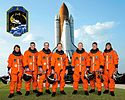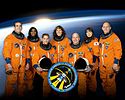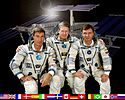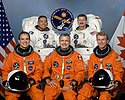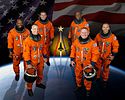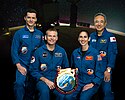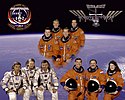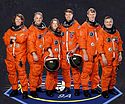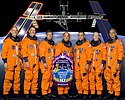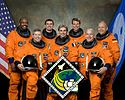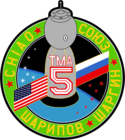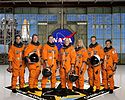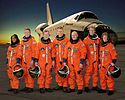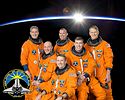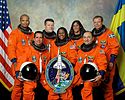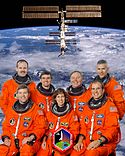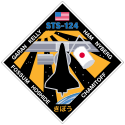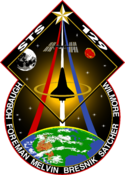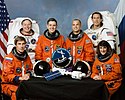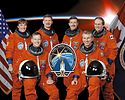Liste der bemannten Missionen zur Internationalen Raumstation
Dies ist eine chronologische Liste aller bemannten Missionen zur Internationalen Raumstation (ISS), einschließlich der nächsten geplanten Flüge. Besuche unbemannter Raumschiffe sind nicht enthalten. Die Mitglieder der ISS-Langzeitbesatzungen sind fett dargestellt. Die „Zeit angedockt“ bezieht sich auf das Raumschiff und stimmt nicht zwingend mit der Verweildauer der einzelnen Besatzungsmitglieder überein.
| Inhaltsverzeichnis: Abgeschlossene Missionen – laufende Missionen – geplante Missionen |
| 1998 – 1999 – 2000 – 2001 – 2002 – 2003 – 2004 – 2005 – 2006 – 2007 – 2008 – 2009 – 2010 – 2011 – 2012 – 2013 – 2014 – 2015 – 2016 – 2017 – 2018 – 2019 – 2020 – 2021 – 2022 – 2023 – 2024 – 2025 |
| Mission | Besatzung (Hinflug) | Foto der Besatzung | Emblem | Anmerkungen |
|---|---|---|---|---|
| Abgeschlossene Missionen | ||||
| 1 STS-88 Space Shuttle Endeavour Start: 4. Dezember 1998 Zeit angedockt: 6 Tage 18h |  | 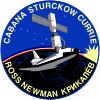 |
| |
| 2 STS-96 Space Shuttle Discovery Start: 27. Mai 1999 Zeit angedockt: 5 Tage 18h | 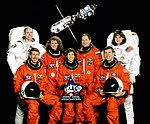 |  |
| |
| 3 STS-101 Space Shuttle Atlantis Start: 19. Mai 2000 Zeit angedockt: 5 Tage 18h |  |  |
| |
| 4 STS-106 Space Shuttle Atlantis Start: 8. September 2000 Zeit angedockt: 7 Tage 21h |  |  |
| |
| 5 STS-92 Space Shuttle Discovery Start: 11. Oktober 2000 Zeit angedockt: 6 Tage 21h |  |  |
| |
| 6 Sojus TM-31 Start: 31. Oktober 2000 Zeit angedockt: ~183 Tage |  |  |
| |
| 7 STS-97 Space Shuttle Endeavour Start: 30. November 2000 Zeit angedockt: 6 Tage 23h |  |  |
| |
| 8 STS-98 Space Shuttle Atlantis Start: 7. Februar 2001 Zeit angedockt: 6 Tage 21h |  |  |
| |
| 9 STS-102 Space Shuttle Discovery Start: 8. März 2001 Zeit angedockt: 8 Tage 21h |  |  |
| |
| 10 STS-100 Space Shuttle Endeavour Start: 19. April 2001 Zeit angedockt: 8 Tage 3h | 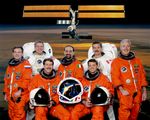 |  |
| |
| 11 Sojus TM-32 Start: 28. April 2001 Zeit angedockt: ~183 Tage |
|  |  |
|
| 12 STS-104 Space Shuttle Atlantis Start: 12. Juli 2001 Zeit angedockt: 8 Tage 1h | 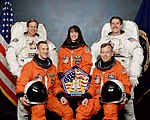 |  |
| |
| 13 STS-105 Space Shuttle Discovery Start: 10. August 2001 Zeit angedockt: 9 Tage 20h |  |  |
| |
| 14 Sojus TM-33 Start: 21. Oktober 2001 Zeit angedockt: ~193 Tage |  |  |
| |
| 15 STS-108 Space Shuttle Endeavour Start: 5. Dezember 2001 Zeit angedockt: 7 Tage 21h |  |  |
| |
| 16 STS-110 Space Shuttle Atlantis Start: 8. April 2002 Zeit angedockt: 7 Tage 2h |  |  |
| |
| 17 Sojus TM-34 Start: 25. April 2002 Zeit angedockt: ~196 Tage |  |  |
| |
| 18 STS-111 Space Shuttle Endeavour Start: 5. Juni 2002 Zeit angedockt: 7 Tage 22h |  | 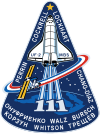 |
| |
| 19 STS-112 Space Shuttle Atlantis Start: 7. Oktober 2002 Zeit angedockt: 6 Tage 21h |  |  |
| |
| 20 Sojus TMA-1 Start: 30. Oktober 2002 Zeit angedockt: ~183 Tage |
|  | 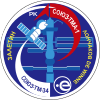 |
|
| 21 STS-113 Space Shuttle Endeavour Start: 24. November 2002 Zeit angedockt: 6 Tage 22h | 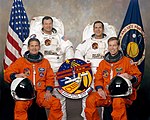 |  |
| |
| Space Shuttle Columbia stürzte am 1. Februar 2003 ab, deshalb blieb die Shuttle-Flotte bis Juli 2005 am Boden. Von 2003 bis 2005 erfolgte kein weiterer Ausbau der Station. | ||||
| 22 Sojus TMA-2 Start: 28. April 2003 Zeit angedockt: ~182 Tage |
|  |
| |
| 23 Sojus TMA-3 Start: 18. Oktober 2003 Zeit angedockt: ~192 Tage |  |  |
| |
| 24 Sojus TMA-4 Start: 19. April 2004 Zeit angedockt: ~185 Tage |  | 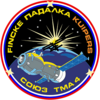 |
| |
| 25 Sojus TMA-5 Start: 14. Oktober 2004 Zeit angedockt: ~190 Tage |
|  |  |
|
| 26 Sojus TMA-6 Start: 15. April 2005 Zeit angedockt: 177 Tage | 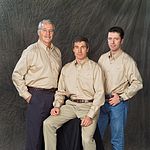 |
| ||
| 27 STS-114 Space Shuttle Discovery Start: 26. Juli 2005 Zeit angedockt: 7 Tage 20 Stunden |  |  |
| |
| 28 Sojus TMA-7 Start: 1. Oktober 2005 Zeit angedockt: 187 Tage 15 Stunden 1 Minute |  |
| ||
| 29 Sojus TMA-8 Start: 30. März 2006 Zeit angedockt: 180 Tage 17 Stunden 34 Minuten |  |
| ||
| 30 STS-121 Space Shuttle Discovery Start: 4. Juli 2006 Zeit angedockt: 8 Tage 19 Stunden |  |  |
| |
| 31 STS-115 Space Shuttle Atlantis Start: 9. September 2006 Zeit angedockt: 6 Tage 2 Stunden 2 Minuten | 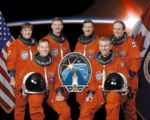 |  |
| |
| 32 Sojus TMA-9 Start: 18. September 2006 Zeit angedockt: 213 Tage 3 Stunden 50 Minuten |  |
| ||
| 33 STS-116 Space Shuttle Discovery Start: 10. Dezember 2006 Zeit angedockt: 7 Tage 23 Stunden 58 Minuten | 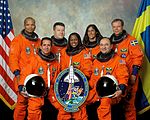 |  |
| |
| 34 Sojus TMA-10 Start: 7. April 2007 Zeit angedockt: 194 Tage 12 Stunden 4 Minuten |  |
| ||
| 35 STS-117 Space Shuttle Atlantis Start: 8. Juni 2007 Zeit angedockt: 8 Tage 19 Stunden 6 Minuten |  | 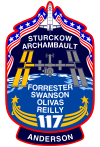 |
| |
| 36 STS-118 Space Shuttle Endeavour Start: 8. August 2007 Zeit angedockt: 8 Tage 17 Stunden 54 Minuten | 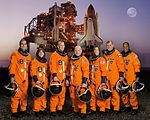 |  |
| |
| 37 Sojus TMA-11 Start: 10. Oktober 2007 Zeit angedockt: 189 Tage 14 Stunden 16 Minuten |  |  |
| |
| 38 STS-120 Space Shuttle Discovery Start: 23. Oktober 2007 Zeit angedockt: 10 Tage 21 Stunden 52 Minuten |  |  |
| |
| 39 STS-122 Space Shuttle Atlantis Start: 7. Februar 2008 Zeit angedockt: 8 Tage 16 Stunden 7 Minuten |  | 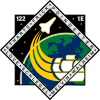 |
| |
| 40 STS-123 Space Shuttle Endeavour Start: 11. März 2008 Zeit angedockt: 11 Tage 20 Stunden 36 Minuten |  |  |
| |
| 41 Sojus TMA-12 Start: 8. April 2008 Zeit angedockt: 196 Tage 11 Stunden 19 Minuten |  |
| ||
| 42 STS-124 Space Shuttle Discovery Start: 31. Mai 2008 Zeit angedockt: 8 Tage 17 Stunden 39 Minuten | 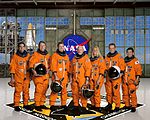 | 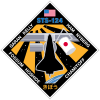 |
| |
| 43 Sojus TMA-13 Start: 12. Oktober 2008 Zeit angedockt: 175 Tage 20 Stunden 31 Minuten | 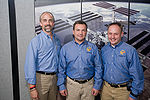 |
| ||
| 44 STS-126 Space Shuttle Endeavour Start: 15. November 2008 Zeit angedockt: 11 Tage 16 Stunden 46 Minuten |  |  |
| |
| 45 STS-119 Space Shuttle Discovery Start: 15. März 2009 Zeit angedockt: 9 Tage 23 Stunden 34 Minuten |  | 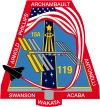 |
| |
| 46 Sojus TMA-14 Start: 26. März 2009 Zeit angedockt: 196 Tage 12 Stunden 2 Minuten | 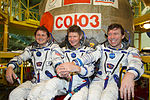 |
| ||
| 47 Sojus TMA-15 Start: 27. Mai 2009 Zeit angedockt: 185 Tage 15 Stunden 20 Minuten |  | |||
| 48 STS-127 Space Shuttle Endeavour Start: 15. Juli 2009 Zeit angedockt: 10 Tage 23 Stunden 39 Minuten | 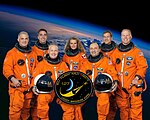 |  |
| |
| 49 STS-128 Space Shuttle Discovery Start: 29. August 2009 Zeit angedockt: 8 Tage 18 Stunden 32 Minuten | 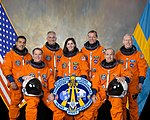 |  |
| |
| 50 Sojus TMA-16 Start: 30. September 2009 Zeit angedockt: 166 Tage 23 Stunden 28 Minuten |  | |||
| 51 STS-129 Space Shuttle Atlantis Start: 16. November 2009 Zeit angedockt: 6 Tage 17 Stunden 2 Minuten |  | 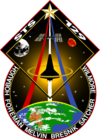 |
| |
| 52 Sojus TMA-17 Start: 20. Dezember 2009 Zeit angedockt: 161 Tage 01 Stunden 16 Minuten | 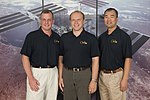 | |||
| 53 STS-130 Space Shuttle Endeavour Start: 8. Februar 2010 Zeit angedockt: 9 Tage 19 Stunden 48 Minuten | 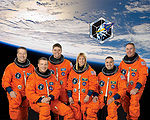 |  |
| |
| 54 Sojus TMA-18 Start: 2. April 2010 Zeit angedockt: 173 Tage 20 Stunden 37 Minuten |  | |||
| 55 STS-131 Space Shuttle Discovery Start: 5. April 2010 Zeit angedockt: 10 Tage 5 Stunden 8 Minuten | 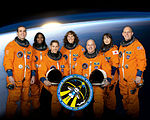 |  |
| |
| 56 STS-132 Space Shuttle Atlantis Start: 14. Mai 2010 Zeit angedockt: 7 Tage 0 Stunden 54 Minuten |  |  |
| |
| 57 Sojus TMA-19 Start: 15. Juni 2010 Zeit angedockt: 161 Tage 2 Stunden 58 Minuten |  | |||
| 58 Sojus TMA-01M Start: 7. Oktober 2010 Zeit angedockt: 157 Tage 4 Stunden 26 Minuten |  | |||
| 59 Sojus TMA-20 Start: 15. Dezember 2010 Zeit angedockt: 157 Tage 1 Stunde 23 Minuten |  | |||
| 60 STS-133 Space Shuttle Discovery Start: 24. Februar 2011 Zeit angedockt: 8 Tage 16 Stunden 46 Minuten |  | 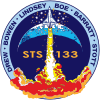 |
| |
| 61 Sojus TMA-21 Start: 4. April 2011 Zeit angedockt: 162 Tage, 1 Stunde, 29 Minuten |  | |||
| 62 STS-134 Space Shuttle Endeavour Start: 16. Mai 2011 Zeit angedockt: 11 Tage, 17 Stunden, 41 Minuten |  |  |
| |
| 63 Sojus TMA-02M Start: 7. Juni 2011 Zeit angedockt: 165 Tage, 1 Stunde, 42 Minuten |  | |||
| 64 STS-135 Space Shuttle Atlantis Start: 8. Juli 2011 Zeit angedockt: 8 Tage, 15 Stunden, 21 Minuten |  |  | ||
| 65 Sojus TMA-22 Start: 14. November 2011 Zeit angedockt: 163 Tage, 2 Stunden, 54 Minuten | 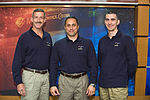 | |||
| 66 Sojus TMA-03M Start: 21. Dezember 2011 Zeit angedockt: 190 Tage, 13 Stunden, 29 Minuten |  | |||
| 67 Sojus TMA-04M Start: 15. Mai 2012 Zeit angedockt: 122 Tage, 18 Stunden, 33 Minuten |  | |||
| 68 Sojus TMA-05M Start: 15. Juli 2012 Zeit angedockt: 124 Tage, 17 Stunden 35 Minuten |  | |||
| 69 Sojus TMA-06M Start: 23. Oktober 2012 Zeit angedockt: 141 Tage, 11 Stunden 14 Minuten |  | |||
| 70 Sojus TMA-07M Start: 19. Dezember 2012 Zeit angedockt: 143 Tage, 08 Stunden 59 Minuten |  | |||
| 71 Sojus TMA-08M Start: 28. März 2013 Zeit angedockt: 165 Tage, 21 Stunden 09 Minuten | 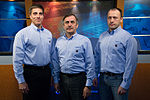 | |||
| 72 Sojus TMA-09M Start: 28. Mai 2013 Zeit angedockt: 165 Tage, 21 Stunden, 16 Minuten |  | |||
| 73 Sojus TMA-10M Start: 25. September 2013 Zeit angedockt: 165 Tage, 21 Stunden, 17 Minuten |  | |||
| 74 Sojus TMA-11M Start: 7. November 2013 Zeit angedockt: 187 Tage, 12 Stunden, 6 Minuten |  | |||
| 75 Sojus TMA-12M Start: 25. März 2014 Zeit angedockt: 166 Tage, 23 Stunden, 8 Minuten |  | |||
| 76 Sojus TMA-13M Start: 28. Mai 2014 Zeit angedockt: 164 Tage, 22 Stunden, 47 Minuten |  | |||
| 77 Sojus TMA-14M Start: 25. September 2014 Zeit angedockt: 166 Tage, 20 Stunden, 33 Minuten |  | |||
| 78 Sojus TMA-15M Start: 23. November 2014 Zeit angedockt: 199 Tage, 16 Stunden, 43 Minuten |  | |||
| 79 Sojus TMA-16M Start: 27. März 2015 Zeit angedockt: 167 Tage, 19 Stunden, 56 Minuten |  | |||
| 80 Sojus TMA-17M Start: 22. Juli 2015 Zeit angedockt: 141 Tage, 7 Stunden, 4 Minuten |  | |||
| 81 Sojus TMA-18M Start: 2. September 2015 Zeit angedockt: 179 Tage, 17 Stunden, 23 Minuten |  | |||
| 82 Sojus TMA-19M Start: 15. Dezember 2015 Zeit angedockt: 185 Tage, 12 Stunden, 19 Minuten |  | |||
| 83 Sojus TMA-20M Start: 18. März 2016 Zeit angedockt: 171 Tage, 18 Stunden, 42 Minuten |  | |||
| 84 Sojus MS-01 Start: 7. Juli 2016 Zeit angedockt: 112 Tage, 20 Stunden, 29 Minuten |  | |||
| 85 Sojus MS-02 Start: 19. Oktober 2016 Zeit angedockt: 170 Tage, 21 Stunden, 59 Minuten |  | |||
| 86 Sojus MS-03 Start: 17. November 2016 Zeit angedockt: 196d 13h 49min |  | |||
| 87 Sojus MS-04 Start: 20. April 2017 Zeit angedockt: 135d 08h 40min |  | |||
| 88 Sojus MS-05 Start: 28. Juli 2017 Zeit angedockt: 138d 07h 20min |  | |||
| 89 Sojus MS-06 Start: 12. September 2017 Zeit angedockt: 167d 20h 13min |  | |||
| 90 Sojus MS-07 Start: 17. Dezember 2017 Zeit angedockt: 166d 0h 37min |  | |||
| 91 Sojus MS-08 Start: 21. März 2018 Zeit angedockt: 194d 12h 17min |  | |||
| 92 Sojus MS-09 Start: 6. Juni 2018 Zeit angedockt: 194d 12h 39min |  | |||
| 93 Sojus MS-10 Start: 11. Oktober 2018 |  |
| ||
| 94 Sojus MS-11 Start: 3. Dezember 2018 Zeit angedockt: 203d 15h 17min |  | |||
| 95 Sojus MS-12 Start: 14. März 2019 Zeit angedockt: 202d 6h 36min |  | |||
| 96 Sojus MS-13 Start: 20. Juli 2019 Zeit angedockt: 200d 6h 39min |  | |||
| 97 Sojus MS-15 Start: 25. September 2019 Zeit angedockt: 204d 6h 11min |  | |||
| 98 Sojus MS-16 Start: 9. April 2020 Zeit angedockt: 195d 09h 18min |  | |||
| 99 SpaceX Demo-2 Start: 30. Mai 2020 Zeit angedockt: 63d 10h 33min |  |  |
| |
| 100 Sojus MS-17 Start: 14. Oktober 2020 Zeit angedockt: 184d 16h 46min |  |
| ||
| 101 SpaceX Crew-1 Start: 16. November 2020 Zeit angedockt: 165d 20h 35min |  |  |
| |
| 102 Sojus MS-18 Start: 9. April 2021 Zeit angedockt: 190d 20h 53min |  |
| ||
| 103 SpaceX Crew-2 Start: 23. April 2021 Zeit angedockt: 199d 17h 44min |  |  |
| |
| 104 Sojus MS-19 Start: 5. Oktober 2021 Zeit angedockt: 175d 18h 59min |  |
| ||
| 105 SpaceX Crew-3 Start: 11. November 2021 Zeit angedockt: 174d 05h 33min |  |  |
| |
| 106 Sojus MS-20 Start: 8. Dezember 2021 Zeit angedockt: 11d 10h 10min |  |
| ||
| 107 Sojus MS-21 Start: 18. März 2022 Zeit angedockt: 194d 12h 22min |  |
| ||
| 108 Ax-1 Start: 8. April 2022 Zeit angedockt: 13d 12h 41min |  |
| ||
| 109 SpaceX Crew-4 Start: 27. April 2022 Zeit angedockt: 169d 16h 28min | 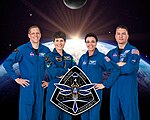 |  |
| |
| 110 Sojus MS-22 Start: 21. September 2022 Zeit angedockt: 187d 16h 46min |  |
| ||
| 111 SpaceX Crew-5 Start: 5. Oktober 2022 Zeit angedockt: 155d 10h 19min |  |  |
| |
| 112 Sojus MS-23 Start: 24. Februar 2023 | unbemannter Start |
| ||
| 113 SpaceX Crew-6 Start: 2. März 2023 |  |  |
| |
| 114 Ax-2 Start: 21. Mai 2023 |  |
| ||
| 115 SpaceX Crew-7 Start: 26. August 2023 |  |  |
| |
| 116 Sojus MS-24 Start: 15. September 2023 |  |
| ||
| 117 Ax-3 Start: 18. Januar 2024 |  |
| ||
| 118 SpaceX Crew-8 Start: 4. März 2024 |  |  |
| |
| 119 Sojus MS-25 Start: 23. März 2024 |  |
| ||
| Laufende Missionen | ||||
| 120 Boe-CFT Start: 5. Juni 2024 |  |
| ||
| 121 Sojus MS-26 Start: 11. September 2024 |  |
| ||
| 122 SpaceX Crew-9 Start: 26. September 2024 |  |  |
| |
| Nächste geplante Missionen | ||||
| SpaceX Crew-10 Start: März 2025[1] |  |  |
| |
| Sojus MS-27 Start: April 2025[2][3] |  |
| ||
| Ax-4 Start: frühestens Frühling 2025[4] |
| |||
| SpaceX Crew-11 Start: frühestens Juli 2025[5] |
| |||
| Sojus MS-28 Start: November 2025[3] |
| |||
| Boeing Starliner-1 Start: frühestens 2025[5] | ein weiterer Raumfahrer (MS) |
| ||
Erklärung der Abkürzungen: CDR, K – Kommandant; P – Pilot; BI – Bordingenieur; MS – Missionsspezialist; JOC – joint operations commander
Siehe auch
- Liste der ISS-Expeditionen
- Liste der Raumfahrer auf der Internationalen Raumstation
- Liste der ISS-Kommandanten
- Liste der bemannten Raumflüge
- Liste der unbemannten Missionen zur Internationalen Raumstation
Weblinks
- ISS-Besatzungsplan der NASA (englisch)
- ISS-Besatzungsplan des Juri-Gagarin-Kosmonautentrainingszentrums (russisch)
- Bevorstehende ISS-Expeditionen auf spacefacts.de (englisch)
Einzelnachweise
- ↑ https://blogs.nasa.gov/commercialcrew/2025/02/11/nasa-spacex-update-crew-10-launch-crew-9-return-dates/
- ↑ NASA Assigns Astronaut Jonny Kim to First Space Station Mission. NASA, 28. August 2024.
- ↑ a b РАСПИСАНИЕ ЗАПУСКОВ 2025: Космодром Байконур, abgerufen am 16. Dezember 2024 (russisch).
- ↑ Launches & Landings. NASA, abgerufen am 2. Oktober 2024.
- ↑ a b NASA Updates 2025 Commercial Crew Plan. NASA, 15. Oktober 2024.
- ↑ Экипажи на подготовке. Juri-Gagarin-Kosmonautentrainingszentrum, abgerufen am 31. Januar 2025.
Auf dieser Seite verwendete Medien
Flag of Canada introduced in 1965, using Pantone colors. This design replaced the Canadian Red Ensign design.
Flag of Italy from 1946 to 2003, when exact colors were specified.
Verwendete Farbe: National flag | South African Government and Pantone Color Picker
| Grün | gerendert als RGB 0 119 73 | Pantone 3415 C |
| Gelb | gerendert als RGB 255 184 28 | Pantone 1235 C |
| Rot | gerendert als RGB 224 60 49 | Pantone 179 C |
| Blau | gerendert als RGB 0 20 137 | Pantone Reflex Blue C |
| Weiß | gerendert als RGB 255 255 255 | |
| Schwarz | gerendert als RGB 0 0 0 |
Autor/Urheber: Zscout370, Lizenz: CC BY-SA 3.0
Flag of Italy from 2003 to 2006
Flagge des Irans. Die dreifarbige Flagge wurde 1906 eingeführt, aber nach der Islamischen Revolution von 1979 wurden die Arabische Wörter 'Allahu akbar' ('Gott ist groß'), in der Kufischen Schrift vom Koran geschrieben und 22-mal wiederholt, in den roten und grünen Streifen eingefügt, so daß sie an den zentralen weißen Streifen grenzen.
Flagge des Vereinigten Königreichs in der Proportion 3:5, ausschließlich an Land verwendet. Auf See beträgt das richtige Verhältnis 1:2.
Flagge des Vereinigten Königreichs in der Proportion 3:5, ausschließlich an Land verwendet. Auf See beträgt das richtige Verhältnis 1:2.
NASA astronaut Sunita Williams, Expedition 32 flight engineer and Expedition 33 commander; along with Russian cosmonaut Yuri Malenchenko (left) and Japan Aerospace Exploration Agency (JAXA) astronaut Akihiko Hoshide, both Expedition 32/33 flight engineers, pose for a portrait following an Expedition 32/33 preflight press conference at NASA's Johnson Space Center.
At the Gagarin Cosmonaut Training Center in Star City, Russia, spaceflight participant Hazzaa Ali Almansoori of the United Arab Emirates (left), Oleg Skripochka of Roscosmos (center) and Jessica Meir of NASA (right) pose for pictures Aug. 30 during crew qualification exams. They will launch Sept. 25 on the Soyuz MS-15 spacecraft from the Baikonur Cosmodrome in Kazakhstan for a mission on the International Space Station.
Besatzung der Space Shuttle-Mission STS-92. Vorne sitzen die Astronauten Pamela A. Melroy (links, Pilotin) und Brian Duffy (Kommandant). In der hinteren Reihe stehen von links nach rechts die Astronauten Leroy Chiao, Michael E. Lopez-Alegria, William S. McArthur, Peter J.K. „Jeff“ Wisoff und Koichi Wakata, alle Missionsspezialisten.
Soyuz TMA-4 Patch
At their crew quarters in Baikonur, Kazakhstan, Expedition 17 Commander Sergei Volkov (center), Flight Engineer Oleg Kononenko (right) and South Korean spaceflight participant So-yeon Yi clasp hands for photographers on April 7, 2008, the eve of their launch to the International Space Station. Volkov, Kononenko and Yi are scheduled to launch to the station on the Soyuz TMA-12 spacecraft from the Baikonur Cosmodrome on April 8 and arrive at the ISS on April 10 to begin what will be six months in space for Volkov and Kononenko. Yi will be in space nine days on the complex, returning to Earth with two of the Expedition 16 crewmembers currently on the station.
View of Soyuz 5 crew Belgian Flight Engineer Frank DeWinne left, of the European Space Agency ESA, Cosmonaut Soyuz Commander Sergei Zalyotin center and Cosmonaut Yuri Lonchakov, Flight Engineer in the Service Module SM/Zvezda during Expedition Five on the International Space Station ISS.
Attired in training versions of their shuttle launch and entry suits, these four astronauts take a break from training to pose for the STS-135 crew portrait. Pictured are NASA astronauts Chris Ferguson (center right), commander; Doug Hurley (center left), pilot; Rex Walheim and Sandy Magnus, both mission specialists.
Expedition 64 backup crew members NASA astronaut Mark Vande Hei, left, Russian cosmonaut Oleg Novitskiy of Roscosmos, center, and Russian cosmonaut Petr Dubrov of Roscosmos pose for a photo during qualification exams Tuesday, Sept. 22, 2020 at the Gagarin Cosmonaut Training Center (GCTC) in Star City, Russia.
Attired in training versions of their shuttle launch and entry suits, these seven astronauts take a break from training to pose for the STS-126 crew portrait. Astronaut Christopher J. Ferguson, commander, is at center; and astronaut Eric A. Boe, pilot, is third from the right. Remaining crewmembers, pictured from left to right, are astronauts Sandra H. Magnus, Stephen G. Bowen, Donald R. Pettit, Robert S. (Shane) Kimbrough and Heidemarie M. Stefanyshyn-Piper, all mission specialists. Magnus is scheduled to join Expedition 18 as flight engineer after launching to the International Space Station on mission STS-126.
Russian cosmonauts Alexander Skvortsov (center), Expedition 23 flight engineer and Expedition 24 commander; and Mikhail Kornienko, Expedition 23/24 flight engineer; along with NASA astronaut Tracy Caldwell Dyson, Expedition 23/24 flight engineer, pose for a portrait following an Expedition 23/24 preflight press conference at NASA's Johnson Space Center. Skvortsov, Kornienko and Caldwell Dyson are scheduled to launch to the International Space Station aboard a Russian Soyuz spacecraft in April 2010.
Expedition 63 Preflight - Expedition 63 crewmember Chris Cassidy of NASA, left, Anatoly Ivanishin of Roscosmos, center, and Ivan Vagner of Roscosmos pose for a group photo after suiting up and preparing for leak checks of their launch and entry suits at the Baikonur Cosmodrome in Kazakhstan as they prepared for launch Thursday, April 9, 2020 on the Soyuz MS-16 spacecraft. A few hours later, they lifted off for a six-and-a-half month mission on the International Space Station.
Attired in training versions of their shuttle launch and entry suits, these seven astronauts take a break from training to pose for the STS-131 crew portrait. Seated are NASA astronauts Alan Poindexter (right), commander; and James P. Dutton Jr., pilot. Pictured from the left (standing) are NASA astronauts Rick Mastracchio, Stephanie Wilson, Dorothy Metcalf-Lindenburger, Japan Aerospace Exploration Agency (JAXA) astronaut Naoko Yamazaki and NASA astronaut Clayton Anderson, all mission specialists.
Photo Date: March 1, 2022 Location: Building 8, Room 183 (Photo Studio). Subject: SpaceX Crew-4 Portrait with NASA astronauts, Robert Hines, Jessica Watkins, Kjell Lindgren and ESA astronaut Samantha Cristoforetti. Photographers: Joshua Valcarcel, Robert Markowitz and Norah Moran
STS-118 crew official portrait.
Pictured from the left are astronauts Richard A. (Rick) Mastracchio, mission specialist; Barbara R. Morgan, a mission specialist and NASA's first educator astronaut; Charles O. Hobaugh, pilot; Scott J. Kelly, commander; mission specialists Tracy E. Caldwell, Canadian Space Agency's Dafydd R. (Dave) Williams, and B. Alvin Drew. The crewmembers are attired in training versions of their shuttle launch and entry suits. NASA astronaut Clayton C. Anderson was to have joined Expedition 15 as flight engineer after launching to the International Space Station aboard Space Shuttle Endeavour on mission STS-118, but was rescheduled and sent to the ISS early, on STS-117.Crew photo of STS-113
- In front are astronauts James D. Wetherbee (right) and Paul S. Lockhart, commander and pilot, respectively. Attired in training versions of the extravehicular mobility unit (EMU) space suits are astronauts Michael E. Lopez-Alegria (left) and John B. Herrington, both mission specialists.
NASA astronaut Michael Fincke (right), Expedition 18 commander; Russian Federal Space Agency cosmonaut Yury Lonchakov (center), flight engineer; and American spaceflight participant Richard Garriott pose for a portrait following an Expedition 18/Soyuz 17 pre-flight press conference at NASA's Johnson Space Center. Fincke, Lonchakov and Garriott are scheduled to launch to the International Space Station in a Soyuz spacecraft in October.
Russian cosmonaut Oleg Kotov (center), Expedition 22 flight engineer and Expedition 23 commander; along with NASA astronaut T.J. Creamer (left) and Japan Aerospace Exploration Agency (JAXA) astronaut Soichi Noguchi, both Expedition 22/23 flight engineers, pose for a portrait following an Expedition 22/23 preflight press conference at NASA's Johnson Space Center. Kotov, Creamer and Noguchi are scheduled to launch to the International Space Station aboard a Russian Soyuz spacecraft in December 2009.
(Dec. 11, 2021) --- The three-person Soyuz MS-20 crew (front row) participates: Japanese spaceflight participant Yusaku Maezawa, Roscosmos cosmonaut Alexander Misurkin, and Japanese spaceflight participant Yozo Hirano.
Astronaut Leroy Chiao (right), Expedition 10 commander and NASA International Space Station (ISS) science officer; cosmonaut Salizhan S. Sharipov (center), Russia's Federal Space Agency Expedition 10 flight engineer and Soyuz commander; and Russian Space Forces cosmonaut Yuri Shargin (left) donned their launch and entry suits and climbed aboard the Soyuz TMA-5 spacecraft October 5, 2004, at the Baikonur Cosmodrome in Kazakhstan for a dress rehearsal of launch day activities leading to their liftoff October 14 to the ISS. Chiao and Sharipov, the first crew of all-Asian extraction, will spend six months on the Station, while Shargin will return to Earth October 23 (U.S.A. time) with cosmonaut Gennady I. Padalka, Expedition 9 commander, and astronaut Edward M. (Mike) Fincke, NASA ISS science officer and flight engineer, who have been in space since April.
In the Integration Facility at the Baikonur Cosmodrome in Kazakhstan, Expedition 50-51 crewmembers Peggy Whitson of NASA (left), Oleg Novitskiy of the Russian Federal Space Agency (Roscosmos, center) and Thomas Pesquet of the European Space Agency (right) pose for pictures Nov. 2 in front of their Soyuz MS-03 spacecraft during a fit check dress rehearsal. They will launch Nov. 18, Baikonur time, for a six-month mission on the International Space Station. NASA/Alexander Vysotsky
* This is the crew patch for the STS-113 mission, which will be the eleventh American (11A) assembly flight to the International Space Station (ISS). The primary mission will be to take the Expedition Six crew to the ISS and return the Expedition Five crew to Earth. STS-113 will be the first flight in the assembly sequence to install a major component in addition to performing a crew exchange. The Port 1 Integrated Truss Assembly (P1) will be the first truss segment on the left side of the ISS. P1 will provide an additional three External Thermal Control System radiators, adding to the three radiators on the Starboard 1 (S1) Integrated Truss Assembly. The installation and outfitting of P1 will require three extravehicular activities (space walks) as well as coordination between the Shuttle Robotic Manipulator System and the Space Station Robotic Manipulator System. The patch depicts the Space Shuttle Endeavour docked to the ISS during the installation of the P1 truss with the gold astronaut symbol in the background.
- The seven stars at the top left center of the patch are the seven brightest stars in the constellation Orion. They represent the combined seven crew members (four Shuttle and three Expedition Six). The three stars to the right of the astronaut symbol represent the returning Expedition Five crew members. The Shuttle crew names are on the solar arrays of the P6 truss. The ISS Expedition crew names are in a chevron that also features the American and Russian flags. The Expedition 6 crew names are on top of the Expedition 5 crew names, since Expedition 6 goes up while Expedition 5 goes down. The Roman Numeral CXIII represents the mission number 113.
Astronaut Peggy Whitson (right), Expedition 16 commander; Russia's Federal Space Agency cosmonaut Yuri Malenchenko, flight engineer and Soyuz commander; and Malaysian spaceflight participant Sheikh Muszaphar Shukor pose for a portrait following a pre-flight press conference at the Johnson Space Center. Whitson, Malenchenko and Shukor are scheduled to launch to the International Space Station in a Soyuz spacecraft in October.
The crew for spacecraft Soyuz TMA-6. From left : John Phillips (USA), Sergei Krikalev (Russia), Roberto Vittori (Italy).
NASA astronaut Dan Burbank (from left) and Russian cosmonauts Anton Shkaplerov and Anatoly Ivanishin are set to launch aboard a Soyuz TMA-22 spacecraft on
Jeff Williams with his Soyuz TMA-20M crew mates Alexey Ovchinin and Oleg Skripochka at NASA's Johnson Space Center in Houston on Thursday, Jan. 7, 2016.)
Designed by the crew members, this patch commemorates the first assembly flight to carry United States-built hardware for constructing the International Space Station (ISS). This flight's primary task is to assemble the cornerstone of the Space Station: the Node with the Functional Cargo Block (fgb).
The rising sun symbolizes the dawning of a new era of international cooperation in space and the beginning of a new program: the International Space Station. The Earth scene outlines the countries of the Station Partners: the United States, Russia, those of the European Space Agency (ESA), Japan, and Canada. Along with the Pressurized Mating Adapters (PMA) and the Functional Cargo Block, the Node is shown in the final mated configuration while berthed to the Space Shuttle during the STS-88/2A mission.
Crew of ISS Expedition 1 launched with Soyuz TM-31
ISS Expedition One Commander William M. (Bill) Shepherd (center) is flanked by Soyuz Commander Yuri P. Gidzenko (right) and Flight Engineer Sergei K. Krikalev (left) in this crew photograph, taken during a break in training in Russia. The three, posed in front of a rendition of the International Space Station, are wearing the Sokol space suits like those they will don for their Soyuz-provided trip to ISS later this month. National flags representing all the international partners run along the bottom of the portrait.
Attired in training versions of their shuttle launch and entry suits, these seven astronauts take a break from training to pose for the STS-127 crew portrait. Pictured on the front row are astronauts Mark Polansky (right), commander, and Doug Hurley, pilot. Remaining crewmembers, pictured from left to right, are astronauts Dave Wolf, Christopher Cassidy, Canadian Space Agency's Julie Payette, Tom Marshburn and Tim Kopra, all mission specialists. Kopra is scheduled to join Expedition 19 as flight engineer after launching to the International Space Station with the STS-127 crew.
Besatzung der Space Shuttle-Mission STS-100. Vorne sitzen die Astronauten Kent V. Rominger (links, Kommandant) und Jeffrey S. Ashby (Pilot). Stehend von links nach rechts Kosmonaut Juri Walentinowitsch Lontschakow, mit den Astronauten Scott F. Parazynski, Umberto Guidoni, Chris A. Hadfield und John Lynch Phillips, alle Missionsspezialisten.
A fire-breathing, five-shaped dragon propels the Crew Dragon spacecraft of NASA's SpaceX Crew-5 mission beyond the confines of a pentagon’s outline and into low-Earth orbit. As the spacecraft ascends above the Earth’s atmosphere and its crew of courageous explorers embarks on their expedition aboard the International Space Station, the dragon’s fire transitions to the colors of NASA’s Commercial Crew Program representing the unrelenting efforts of the many teams who have met this challenge with unparalleled determination. The sun shines its light on this international team as they bravely pursue.
European Space Agency (ESA) Soyuz crewmember Pedro Duque (left), cosmonaut Alexander Y. Kaleri, Expedition 8 flight engineer representing Rosaviakosmos, and C. Michael Foale, mission commander, are photographed during a pre-flight press conference at Johnson Space Center (JSC).
Emblem of Nasa's STS-110 mission.
- The STS-110 mission begins the third and final phase of construction for the International Space Station (ISS) by delivering and installing the SØ truss segment that will be carried into orbit in the payload bay of the Space Shuttle Atlantis. The Station’s robotic arm will remove the SØ segment from the Shuttle’s payload bay and place it on top of the United States Laboratory. During several space walks, SØ will be mechanically attached to ISS, and then multiple cables will be connected allowing electrical power and communications to flow between SØ and ISS. The STS-110 crew patch is patterned after the cross section of the SØ truss, and encases the launch of the Shuttle Atlantis and a silhouette of the ISS as it will look following mission completion. The successfully installed SØ segment is highlighted in gold. The SØ truss will serve as the cornerstone for the remaining ISS truss segments which together will span a distance greater than the length of a football field. This truss holds the Station’s massive solar arrays, providing electrical power for the modules of all the International Partners, and enables ISS to reach its full potential as a world-class research facility.
Besatzung der Space Shuttle-Mission STS-97. Kommandant Brent W. Jett (vorne rechts), Pilot Michael J. Bloomfield (vorne links), Marc Garneau (mitte), Carlos I. Noriega (hinten links) und Joseph R. Tanner (hinten rechts).
Boeing Crew Flight Test (CFT) astronauts Butch Wilmore and Suni Williams in T-38 pre-flight activities at Ellington Field. Photo Date: August 16, 2022. Location: Ellington Field, Hangar 276/Flight Line. Photographer: Robert Markowitz
The STS-118 patch represents Space Shuttle Endeavour on its mission to help complete the assembly of the International Space Station (ISS), and symbolizes the pursuit of knowledge through space exploration. The flight will accomplish its ISS 13A.1 assembly tasks through a series of spacewalks, robotic operations, logistics transfers, and the exchange of one of the three long-duration expedition crew members. On the patch, the top of the gold astronaut symbol overlays the starboard S-5 truss segment, highlighting its installation during the mission. The flame of knowledge represents the importance of education, and honors teachers and students everywhere. The seven white stars and the red maple leaf signify the American and Canadian crew members, respectively, flying aboard Endeavour.
This is the mission patch of STS-108. Space Shuttle Endeavour is seen approaching the International Space Station. Two astronaut symbols represent the crew commanders of both ISS expeditions. The ascending one represents cosmonaut Yury Onufriyenko of Russia. (The ascending astronaut symbol shows a flag of Russia.) The descending astronaut symbol represents Frank Culbertson of the USA. This represents crew rotation, as three stars are depicted on the symbols. The space shuttle crew members are depicted along the border while the ISS crews are depicted along the chevron on the border of the patch.
- This is the insignia for the STS-108 mission, which marks a major milestone in the assembly of the International Space Station (ISS) as the first designated Utilization Flight, UF-1. The crew of Endeavour will bring the Expedition Four crew to ISS and return the Expedition Three crew to Earth. Endeavour will also launch with a Multi-Purpose Logistics Module (MPLM) that will be berthed to ISS and unloaded. The MPLM will be returned to Endeavour for the trip home and used again on a later flight. The crew patch depicts Endeavour and the ISS in the configuration at the time of arrival and docking. The Station is shown viewed along the direction of flight as will be seen by the Shuttle crew during their final approach and docking along the X-axis. The three ribbons and stars on the left side of the patch signify the returning Expedition Three crew. The red, white and blue order of the ribbons represents the American commander for that mission. The three ribbons and stars on the right depict the arriving Expedition Four crew. The white, blue, red order of the Expedition Four ribbon matches the color of the Russian flag and signifies that the commander of Expedition Four is a Russian cosmonaut. Each white star in the center of the patch represents the four Endeavour crew members. The names of the four astronauts who will crew Endeavour are shown along the top border of the patch. The three astronauts and three cosmonauts of the two expedition crews are shown on the chevron at the bottom of the patch.
Das STS-135 Emblem repräsentiert das Space Shuttle Atlantis, welches gerade seine Mission zur Wiederauffüllung der Internationalen Raumstation beginnt. Die Atlantis ist in der Mitte über Elementen des NASA-Emblems angeordnet, schildernd wie das Space Shuttle das Herz der NASA in den letzten 30 Jahren wurde. Es erweist auch der gesamten NASA und den Industriepartnern die Ehre, die all die unglaublichen Leistungen des Space Shuttles möglich machten. Omega, der letzte Buchstabe im griechischen Alphabet, identifiziert diese Mission als den letzten Flug des Space-Shuttle-Programms.
Die Startbesatzung der Sojus TMA-7: Weltraumtourist Gregory Olsen, Kommandant Waleri Tokarew und Bordingenieur William McArthur (von links nach rechts), fotografiert am 20. September 2005 in Baikonur (Kasachstan).
Attired in training versions of their shuttle launch and entry suits, these six astronauts take a break from training to pose for the STS-129 crew portrait. Pictured on the front row are astronauts Charlie Hobaugh (left), commander; and Barry Wilmore, pilot. From the left (back row) are astronauts Leland Melvin, Mike Foreman, Robert Satcher and Randy Bresnik, all mission specialists.
STS-104, International Space Station (ISS) assembly mission 7A, marks the completion of the initial assembly phase of ISS. The 7A crew will install, activate, and perform the first space walk from the Joint Airlock. The Joint Airlock will enable crews to perform space walks in either United States or Russian spacesuits while recovering over 90 percent of the gases that were previously lost when airlocks were vented to the vacuum of space. This patch depicts the launch of Space Shuttle Atlantis and the successful completion of the mission objectives as signified by the view of the ISS with the airlock installed. The astronaut symbol is displayed behind Atlantis as a tribute to the many crews that have flown before. The hard work, dedication, and teamwork of the airlock team is represented by the ISS components inside the payload bay which include the Joint Airlock and four high pressure gas tanks containing nitrogen and oxygen. In the words of a STS-104 crew spokesperson, "The stars and stripes background is symbolic of the commitment of a nation to this challenging international endeavor and to our children who represent its future."
Besatzung der Space Shuttle-Mission STS-106. Die Astronauten Terrence W. Wilcutt (vorne rechts, Kommandant) und Scott D. Altman (vorne links, Pilot). Im Hintergrund von links nach rechts die Missionsspezialisten Kosmonaut Boris V. Morukov, die Astronauten Richard A. Mastracchio, Edward Tsang Lu, Daniel C. Burbank und Kosmonaut Yuri I. Malenchenko.
SpaceX Crew-5 Official Crew Portrait - Anna Kikina, Josh Cassada, Nicole Mann and Koichi Wakata
NASA astronaut Terry Virts (right), Expedition 42 flight engineer and Expedition 43 commander; Russian cosmonaut Anton Shkaplerov and European Space Agency astronaut Samantha Cristoforetti, both Expedition 42/43 flight engineers, pose for a portrait following an Expedition 42/43 preflight press conference at NASA's Johnson Space Center.
The STS-126 patch represents Space Shuttle Endeavour on its mission to help complete the assembly of the International Space Station (ISS). The inner patch outline depicts the Multi-Purpose Logistics Module (MPLM) Leonardo. This reusable logistics module will carry the equipment necessary to sustain a crew of six on board the ISS and will include additional crew quarters, exercise equipment, galley, and life support equipment. In addition, a single expedition crew member will launch on STS-126 to remain on board ISS, replacing an expedition crew member who will return home with the shuttle crew. Near the center of the patch, the constellation Orion reflects the goals of the human spaceflight program, returning us to the Moon and on to Mars, the red planet, which are also shown. At the top of the patch is the gold symbol of the astronaut office. The sunburst, just clearing the horizon of the magnificent Earth, powers all these efforts through the solar arrays of the ISS current configuration orbiting high above.
The STS-101 mission patch commemorates the third Space Shuttle flight supporting the assembly of the International Space Station (ISS). This flight's primary tasks are to outfit the ISS and extend its lifetime, and to conduct a spacewalk to install external components in preparation for the docking of the Russian Service Module, Zvezda, and the arrival of the first ISS crew. The Space Shuttle is depicted in an orbit configuration prior to docking with the ISS. The ISS is depicted in the stage of assembly completed for the STS-101 mission, which consists of the United States-built Unity module and the Russian-built Zarya module. The three large stars represent the third ISS mission in the assembly sequence. The elements and colors of the border reflect the flags of the nations represented by the STS-101 crew members, the United States and Russia. The NASA insignia design for Shuttle flights is reserved for use by the astronauts and for other official use as the NASA Administrator may authorize. Public availability has been approved only in the form of illustrations by the various news media. When and if there is any change in this policy, which is not anticipated, it will be publicly announced.
In the Integration Building at the Baikonur Cosmodrome in Kazakhstan, Expedition 51 crewmembers Fyodor Yurchikhin of the Russian Federal Space Agency (Roscosmos, left) and Jack Fischer of NASA (right) pose for pictures April 6 in front of their Soyuz MS-04 spacecraft as part of pre-launch training preparations. Fischer and Yurchikhin will launch April 20 on the Soyuz MS-04 spacecraft for a four and a half month mission on the International Space Station.
Crew-7 Portrait (Jasmin Moghbeli, Andreas Mogensen, Satoshi Furukawa and Konstantin Borisov)
PHOTO DATE: 03-03-23 LOCATION: Building 8, Room 183 - Photo Studio
PHOTOGRAPHER: Bill Stafford and Robert MarkowitzBesatzung der Space Shuttle-Mission STS-96. In der vorderen Reihe sitzen von links nach rechts die Astronauten Kent V. Rominger (Kommandant), Ellen Ochoa (Missionspezialistin) und Rick D. Husband (Pilot). In der hinteren Reihe stehen von links nach rechts die Missionsspezialisten Daniel T. Barry, Julie Payette, Waleri Tokarew und Tamara Jernigan.
Axiom Mission 3 crew members Michael Lopez-Alegria, Walter Villadei, Alper Gezeravci, and Marcus Wandt docked to the forward port of the Harmony module of the International Space Station Jan. 20 following a launch from NASA’s Kennedy Space Center in Florida Jan. 18. Following docking, the crew opened the hatch of the SpaceX Dragon spacecraft and floated aboard the International Space Station where they were greeted by members of the Expedition 70 crew. The four private crew members will conduct a mission living and working aboard the microgravity laboratory on the third private astronaut mission as part of NASA’s effort to open to space to more people and science
STS-123 crew portrait. From the right (front row) are astronauts Dominic L. Gorie, commander; and Gregory H. Johnson, pilot. From the left (back row) are astronauts Richard M. Linnehan, Robert L. Behnken, Garrett E. Reisman, Michael J. Foreman and Japan Aerospace Exploration Agency's (JAXA) Takao Doi, all mission specialists.
Besatzung der Space Shuttle-Mission STS-102 (oben), die Crew der ISS Expedition 1 (unten links) und die Crew der ISS Expedition 2 (unten rechts). Die Besatzung von STS-102 von links nach rechts die Astronauten James M. Kelly (Pilot), Andrew S.W. Thomas (Missionsspezialist), James D. Wetherbee (Kommandant) und Paul W. Richards (Missionsspezialist). Unten links ist die Crew der ISS Expedition 1 zu sehen; von links nach rechts Kosmonaut Sergei Konstantinowitsch Krikaljow (Flugingenieur), Astronaut William M. Shepherd (Kommandant) und Kosmonaut Yuri P. Gidzenko (Soyuz-Kommandant). Unten rechts die Crew der ISS Expedition 2, welche den Astronauten James S. Voss (links), den Kosmonauten Yury V. Usachev (Kommandant) und die Astronautin Susan J. Helms umfasst.
Soyuz TMA-3 crew patch, designed by Luc van den Abeelen.
Attired in training versions of their shuttle launch and entry suits, these seven astronauts take a break from training to pose for the STS-119 crew portrait. From the right (front row) are NASA astronauts Lee Archambault, commander, and Tony Antonelli, pilot. From the left (back row) are NASA astronauts Joseph Acaba, John Phillips, Steve Swanson, Richard Arnold and Japan Aerospace Exploration Agency astronaut Koichi Wakata, all mission specialists. Wakata is scheduled to join Expedition 18 as flight engineer after launching to the International Space Station on STS-119.
Autor/Urheber: Flappiefh, Lizenz: CC BY-SA 3.0
Logo of the Soyouz TMA-1 mission
At the Baikonur Cosmodrome in Kazakhstan, Expedition 57 crew members Alexey Ovchinin of Roscosmos (left) and Nick Hague of NASA (right) pose for pictures in front of their Soyuz MS-10 spacecraft Sept. 26 during final pre-launch training. Ovchinin and Hague will launch Oct. 11 in the Soyuz MS-10 from the Baikonur Cosmodrome for a six-month mission on the International Space Station.
Expedition Seven Commander Yuri I. Malenchenko (left), and NASA ISS Science Officer and Flight Engineer Edward T. Lu pose for their crew portrait while in training at the Gagarin Cosmonaut Training Center in Star City, Russia for their scheduled launch in a Soyuz TMA-2 spacecraft later this year. Malenchenko represents Rosaviakosmos, the Russian Aviation and Space Agency.
The official patch for the Soyuz TMA-11 mission, carrying Expedition 16 to the International Space Station.
The Soyuz Taxi crewmembers pose for a group photo in the Zvezda Service Module on the International Space Station (ISS). The “taxi” crew arrived at the orbital outpost on April 27, 2002 at 2:56 a.m. (CDT) as the two vehicles flew over Central Asia. Gidzenko represents Rosaviakosmos. From the left are Commander Yuri Gidzenko, who was a member of the first resident crew of the ISS; Flight Engineer Roberto Vittori of the European Space Agency (ESA); and South African space flight participant Mark Shuttleworth. Visible in the background is a portrait of cosmonaut Yuri Gagarin posted in the module.
These five astronauts and cosmonaut take a break from training to pose for the STS-112 crew portrait. Astronauts Jeffrey S. Ashby and Pamela A. Melroy, commander and pilot, respectively, are in the center of the photo. The mission specialists are, from left to right, astronauts Sandra H. Magnus, David A. Wolf and Piers J. Sellers and cosmonaut Fyodor Yurchikhin, who represents Rosaviakosmos.
Photo Date: November 20, 2020.
Location: Building 8, Room 183 (Photo Studio) Subject: SpaceX Crew-3 porait with NASA astronauts Raja Chari, Thomas Marshburn, Kayla Barron and ESA astronaut Matthias Maurer.
Photographer: Robert MarkowitzThis is the insignia for STS-98, which marks a major milestone in assembly of the International Space Station (ISS). Atlantis' crew will deliver the United States Laboratory, Destiny, to the ISS. Destiny will be the centerpiece of the ISS, a weightless laboratory where expedition crews will perform unprecedented research in the life sciences, materials sciences, Earth sciences, and microgravity sciences. The laboratory is also the nerve center of the Station, performing guidance, control, power distribution, and life support functions. With Destiny's arrival, the Station will begin to fulfill its promise of returning the benefits of space research to Earth's citizens. The crew patch depicts the Space Shuttle with Destiny held high above the payload bay just before its attachment to the ISS. Red and white stripes, with a deep blue field of white stars, border the Shuttle and Destiny to symbolize the continuing contribution of the United States to the ISS. The constellation Hercules, seen just below Destiny, captures the Shuttle and Station's team efforts in bringing the promise of orbital scientific research to life. The reflection of Earth in Destiny's window emphasizes the connection between space exploration and life on Earth.
Logo of Nasa's STS-100 mission.
- The STS-100/6A emblem reflects the complex interaction of robotics and extravehicular activity (EVA) on this mission. During the mission spacewalks will be conducted to deploy the International Space Station Remote Manipulator System (SSRMS). The EVA helmet frames the patch, with the Canadian-built SSRMS shown below the visor. Reflected in the visor is the Space Shuttle Endeavour, with the International Space Station rising above the horizon at orbital sunrise. Endeavour's payload bay houses a Spacelab pallet, itself holding the SSRMS and the Space Station Ultra High Frequency Antenna, and the Italian-built Multi-Purpose Logistics Module "Raffaello." American, Russian, Canadian, and Italian astronauts compose the crew, and their flags are stylized in the lower portion of the emblem. Ten stars adorn the sky, representing the children of the STS-100 crew and the future of space exploration.
Autor/Urheber: Montage: Erick Soares3
Images: NASA, Lizenz: CC0
Crew from the Axiom Mission 2.
Russian cosmonaut Pavel Vinogradov (center), Expedition 35 flight engineer and Expedition 36 commander; along with NASA astronaut Chris Cassidy (left) and Russian cosmonaut Alexander Misurkin, both Expedition 35/36 flight engineers, pose for a portrait following an Expedition 35/36 preflight press conference at NASA's Johnson Space Center.
The STS-105 crew patch symbolizes the exchange of the Expedition Two and Expedition Three crews aboard the International Space Station. The three gold stars near the ascending Orbiter represent the U.S. commanded Expedition Three crew as they journey into space, while the two gold stars near the descending Orbiter represent the Russian commanded Expedition Two crew and their return to Earth. The plumes of each Orbiter represent the flags of the United States and Russia and symbolize the close cooperation between the two countries. The Astronaut Office symbol, a star with three rays of light, depicts the unbroken link between Earth and the newest and brightest star on the horizon, the International Space Station (ISS). The ascending and descending Orbiters form a circle that represents both the crew rotation and the continuous presence in space aboard the ISS. The names of the four astronauts who will crew Discovery are shown along the border of the patch. The names of the Expedition Three and Expedition Two crews are shown on the chevron at the bottom of the patch. The NASA insignia design for Shuttle flights is reserved for use by the astronauts and for other official use as the NASA Administrator may authorize. Public availability has been approved only in the form of illustrations by the various news media. When and if there is any change in this policy, which we do not anticipate, it will be publicly announced.
Japan Aerospace Exploration Agency (JAXA) astronaut Koichi Wakata (left), Expedition 38 flight engineer and Expedition 39 commander; along with Russian cosmonaut Mikhail Tyurin (center) and NASA astronaut Rick Mastracchio, both Expedition 38/39 flight engineers, pose for a portrait following an Expedition 38/39 preflight press conference at NASA's Johnson Space Center.
Following the March 19 Expedition 36/37 (Soyuz 35) press conference, crew members pose for pictures. From left are Russian cosmonaut Fyodor Yurchikhin, NASA astronaut Karen Nyberg and European Space Agency astronaut Luca Parmitano. The trio earlier fielded questions from reporters and social media representatives.
Russian cosmonaut Andrey Borisenko (right), Expedition 27 flight engineer and Expedition 28 commander; Russian cosmonaut Alexander Samokutyaev (center) and NASA astronaut Ron Garan, both Expedition 27/28 flight engineers, pose for a portrait following an Expedition 27/28 preflight press conference at NASA's Johnson Space Center. Borisenko, Samokutyaev and Garan are scheduled to launch to the International Space Station aboard a Russian Soyuz spacecraft in March 2011.
Expedition 15 crewmembers posed for photos at the conclusion of a Dec. 13 press conference at the Johnson Space Center. From the left are Charles Simonyi, space flight participant; Oleg Kotov, flight engineer and Soyuz commander; and Fyodor Yurchikhin, commander. Kotov and Yurchikhin represent Russia's Federal Space Agency.
Attired in training versions of their shuttle launch and entry suits, these six astronauts take a break from training to pose for the STS-130 crew portrait. Seated are astronauts George Zamka (right), commander; and Terry Virts, pilot. From the left (standing) are astronaut Nicholas Patrick, Robert Behnken, Kathryn Hire and Stephen Robinson, all mission specialists.
Emblem of Nasa's STS-122 mission.
- The STS-122 patch depicts the continuation of the voyages of the early explorers to today's frontier, space. The ship denotes the travels of the early expeditions from the east to the west. The space shuttle shows the continuation of that journey along the orbital path from west to east. A little more than 500 years after Columbus sailed to the new world, the STS-122 crew will bring the European laboratory module "Columbus" to the International Space Station to usher in a new era of scientific discovery.
In the Integration Facility at the Baikonur Cosmodrome in Kazakhstan, Expedition 56 crewmembers Serena Aunon-Chancellor of NASA (left), Sergey Prokopyev of Roscosmos (center) and Alexander Gerst of the European Space Agency (right) pose for pictures in their Russian Sokol launch and entry suits in front of the Soyuz MS-09 spacecraft May 20 as part of their first fit check dress rehearsal activities. They will launch June 6 on the Soyuz MS-09 spacecraft from Baikonur for a six-month mission on the International Space Station.
Expedition 71 NASA astronaut Tracy Dyson, Roscosmos cosmonaut Oleg Novitskiy, and Belarus spaceflight participant Marina Vasilevskaya are seen in quarantine, behind glass, during a press conference, Wednesday, March 20, 2024 a the Cosmonaut Hotel in Baikonur, Kazakhstan. Dyson, Novitskiy, and Belarus spaceflight participant Marina Vasilevskaya are scheduled to launch aboard their Soyuz MS-25 spacecraft on March 21. Photo Credit: (NASA/Bill Ingalls)
NASA astronaut Barry Wilmore (center), Expedition 41 flight engineer and Expedition 42 commander; along with Russian cosmonauts Alexander Samokutyaev and Elena Serova, both Expedition 41/42 flight engineers, pose for a portrait following an Expedition 41/42 preflight press conference at NASA's Johnson Space Center.
Attired in training versions of their shuttle launch and entry suits, these seven astronauts take a break from training to pose for the STS-128 crew portrait. Seated are NASA astronauts Rick Sturckow (right), commander; and Kevin Ford, pilot. From the left (standing) are astronauts Jose Hernandez, John "Danny" Olivas, Nicole Stott, European Space Agency's Christer Fuglesang and Patrick Forrester, all mission specialists. Stott is scheduled to join Expedition 20 as flight engineer after launching to the International Space Station on STS-128.
Brazilian Space Agency astronaut Marcos C. Pontes (left); astronaut Jeffrey N. Williams, Expedition 13 NASA space station science officer and flight engineer; and cosmonaut Pavel V. Vinogradov, commander representing Russia's Federal Space Agency, take a break from training to pose for a portrait at Johnson Space Center.
Alexander Gerst, Expedition 40/41 flight engineer representing the European Space Agency, cosmonaut Maxim Suraev, Expedition 40 flight engineer and Expedition 41 commander and astronaut Reid Wiseman of NASA, Expedition 40/41 flight engineer pose for photos following a March 18 press conference at NASA's Johnson Space Center.
(March 2004) --- These seven astronauts take a break from training to pose for the STS-114 crew portrait. In front are astronauts Eileen M. Collins (right), commander; Wendy B. Lawrence, mission specialist; and James M. Kelly, pilot. In back are astronauts Stephen K. Robinson (left), Andrew S. W. Thomas, Charles J. Camarda, and Soichi Noguchi, all mission specialists. Noguchi represents Japan Aerospace Exploration Agency (JAXA). Image courtesy NASA.
These seven astronauts take a break from training to pose for the STS-117 crew portrait. Scheduled to launch aboard the Space Shuttle Atlantis are (from the left) astronauts Clayton C. Anderson, James F. Reilly, Steven R. Swanson, mission specialists; Frederick W. Sturckow, commander; Lee J. Archambault, pilot; Patrick G. Forrester and John D. Olivas, mission specialists
STS122-S-002 (24 April 2007) --- These seven astronauts take a break from training to pose for the STS-122 crew portrait. From the left (front row) are astronauts Stephen N. Frick, commander; European Space Agency's (ESA) Leopold Eyharts; and Alan G. Poindexter, pilot. From the left (back row) are astronauts Leland D. Melvin, Rex J. Walheim, Stanley G. Love and European Space Agency's (ESA) Hans Schlegel, all mission specialists. Eyharts will join Expedition 16 in progress to serve as a flight engineer aboard the International Space Station. The crewmembers are attired in training versions of their shuttle launch and entry suits.
The STS-131/19A crew patch highlights the Space Shuttle in the Rendezvous Pitch Maneuver (RPM). This maneuver is heavily photographed by the International Space Station (ISS) astronauts, and the photos are analyzed back on earth to clear the Space Shuttle's thermal protection system for re-entry. The RPM illustrates the teamwork and safety process behind each Space Shuttle launch. In the Space Shuttle's cargo bay is the Multi-Purpose Logistics Module (MPLM), Leonardo, which is carrying several science racks, the last of the four crew quarters, and supplies for the ISS. Out of view and directly behind the MPLM, is the Ammonia Tank Assembly (ATA) that will be used to replace the current ATA. This will take place during three Extra Vehicular Activities (EVAs). The 51.6° Space Shuttle orbit is illustrated by the three gold bars of the astronaut symbol, and its elliptical wreath contains the orbit of the ISS. The star atop the astronaut symbol is the dawning sun, which is spreading its early light across the Earth. The background star field contains seven stars, one for each crewmember; they are proud to represent the United States and Japan during this mission.
Crew from Axiom Mission 1
The first International Space Station crew patch is a simplified graphic of the station complex when fully completed. The station is seen with solar arrays turned forward. The last names of the Expedition One crew, Soyuz pilot Yuri Gidzenko, flight engineer Sergei Krikalev, and expedition commander William (Bill) Shepherd, appear under the station symbol.
NASA astronaut Kevin Ford (left), Expedition 33 flight engineer and Expedition 34 commander; along with Russian cosmonauts Oleg Novitskiy (center) and Evgeny Tarelkin, both Expedition 33/34 flight engineers, pose for a portrait following an Expedition 33/34 preflight press conference at NASA's Johnson Space Center.
Space Shuttle mission STS-127 is the 32nd construction flight of the International Space Station (ISS) and the final of a series of three flights dedicated to the assembly of the Japanese "Kibo" laboratory complex. In addition to delivering, installing, and servicing an external scientific platform that will be attached to the end of the Japanese module, STS-127 will bring up a new ISS crew member and return another one to Earth, replace vital components of the ISS electrical production system, and transfer various pieces of hardware to ISS. Five spacewalks and the operation of four different robotic arms will be required to accomplish these tasks over 10 days. A crew spokesperson had the following words for the patch. "Bathed in sunlight, the blue Earth is represented without boundaries to remind us that we all share this world. In the center, the golden flight path of the space shuttle turns into the three distinctive rays of the astronaut symbol culminating in the star-like emblem characteristic of the Japanese Space Agency, yet soaring further into space as it paves the way for future voyages and discoveries for all humankind."
Official patch for the Soyuz TMA-2 mission, carrying Expedition 7 to the International Space Station.
Flag of South Korea from October 1997 to May 2011. In May 2011, the exact colors were specified into their current shades.
Sailing across the Crew 6 patch the ship represents both our destination the International Space Station and the vessels that countless explorers have steered into the unknown The ISS anchors us on the dawn of missions to the Moon and Mars The ship's sail a symbol of the 2012 Cosmonaut class has relative radii matching those of Earth the Moon and Mars The Draco constellation represents the Commercial Crew Program and shares a name with the thrusters that maneuver our Dragon spacecraft The ship's Dragon figurehead looks to the future as we also look back at Earth grateful for the tireless hours of all who support our mission.
NASA's insignia for SpaceX's Crew-10 mission to the International Space Station with NASA astronauts Anne McClain and Nichole Ayers, JAXA astronaut Takuya Onishi and Roscomsos cosmonaut Kirill Peskov. The 10-sided patch has the roman numeral X in the center with a Dragon, also the capsule's namesake, with wings out in full flight to represent the four professional pilots that make up the crew. The red, white, and blue stars are the flag colors of each crew members' home country, and the brightest stars represent the crew's closest family members and support system.
This Soyuz TMA-5 patch was designed by Alex Panchenko:
"I've started design works of patches for Soyuz TMA-5 (ISS-10 flight) back in July 2004, when first sketches - drawings made in Starbucks coffee and later presented them for approval to Soyuz commander S. Sharipov. It was still not clear who is going to be third crew member of Soyuz and in this case I was preparing for Soyuz TMA-5 flight design in two variants (with name of Polonsky and with name of Shargin - both candidates on third seat in Soyuz).
During design work with Soyuz TMA-5 patch my idea was to present Soyuz panels as symbolic flags of Russia and United States, and base of design is a window view outside. Crew names are in the same order as their actual seats inside Soyuz. Commander S. Sharipov in center, L. Chiao on the left from commander and Y. Shargin on the right side."
At the Baikonur Cosmodrome in Kazakhstan, Expedition 20 Flight Engineer Bob Thirsk of the Canadian Space Agency, Russian Cosmonaut Roman Romanenko and Flight Engineer Frank De Winne of the European Space Agency pose for photographers on 18 May 2009 as they prepared for a check of the Soyuz TMA-15 spacecraft they will launch in on 27 May on a trip to the International Space Station. The trio will join three other residents on the station to form a six-person crew for the first time.
Astronaut Michael E. Lopez-Alegria (left), Expedition 14 commander and NASA space station science officer; spaceflight participant Anousheh Ansari; and cosmonaut Mikhail Tyurin, flight engineer and Soyuz commander representing Russia's Federal Space Agency, participate in the traditional flag-raising ceremony at the Cosmonaut Hotel in Baikonur, Kazakhstan on Sept. 5, 2006 as they prepare for their launch Sept. 18 on a Soyuz TMA-9 spacecraft to the International Space Station. Photo credit: Victor Zelentsov/NASA
Logo of Crew-7.
- Central to the Crew-7 patch is the colorful Earth, with its beauty and magnificence standing out against the white dragon and black background. The caring dragon holds the Earth protectively, highlighting that every aspect of Crew-7’s long-duration mission is ultimately for the benefit of our home planet and those on it. The dragon is a shoutout to the namesake of the Crew Dragon capsule delivering the crew of four to and from the International Space Station.
- The dragon is on guard for threats against the Earth, its neck craned in the shape of a “7” to represent the seventh operational flight of the Crew Dragon spacecraft to the International Space Station. The dragon’s tail curves upwards towards a golden star, symbolizing the ascent towards the stars in honor of the pioneering spirit and perseverance that continue to propel us further in human space exploration.
- The colors blue, white, and red on the tail symbolize the international make-up of the four crew members, with the colors encompassing those used in the flags of all four nations – the United States of America, Denmark, Japan, and the Russian Federation. The crew is proud to represent the progress that can be achieved for all of humanity when we work together in unity. The Crew-7 astronauts would like to dedicate this patch to all those who contributed to the success of the Crew-7 mission, especially their families, and to the next generation of explorers.
Paolo Nespoli of ESA (European Space Agency), Sergey Ryazanskiy of the Russian space agency Roscosmos, and NASA astronaut Randy Bresnik, who are scheduled to launch to the International Space Station in late spring, participated in a news conference Jan. 25, at the agency’s Johnson Space Center in Houston. This will be Bresnik’s second trip to the space station, the second expedition for Ryazanskiy, and Nespoli’s third trip to the space station. They will be part of Expeditions 52 and 53.
NASA’s SpaceX Crew-10 members (pictured from left to right) NASA astronaut Nichole Ayers, Roscosmos cosmonaut Kirill Peskov, NASA astronaut Anne McClain, and JAXA (Japan Aerospace Exploration Agency) astronaut Takuya Onishi
Russian cosmonaut Gennady Padalka (center), Expedition 31 flight engineer and Expedition 32 commander; along with NASA astronaut Joe Acaba (left) and Russian cosmonaut Sergei Revin, both Expedition 31/32 flight engineers, pose for a portrait following an Expedition 31/32 preflight press conference at NASA's Johnson Space Center.
Besatzung der Space Shuttle-Mission STS-98. Vorne sitzen die Astronauten Kenneth D. Cockrell (rechts, Kommandant) und Mark L. Polansky (Pilot). Stehend von links nach rechts die Astronauten Robert L. Curbeam, Marsha S. Ivins, und Thomas D. Jones, alle Missionsspezialisten.
Designed by the crew members, the STS-92 patch symbolizes the second mission to carry U.S.-built elements to the International Space Station (ISS) for assembly. The black silhouette of the Space Shuttle Discovery stands out against the deep blue background of space in low Earth orbit. In the foreground in gray is a profile view of the ISS as it appears when the shuttle and crew arrive, with the station consisting of the Unity node, its two pressurized mating adapters (PMA), the Zarya functional cargo block, the Zvezda service module, and the Progress cargo vehicle.
Following the shuttle's rendezvous and docking, the ISS configuration will be augmented by the two elements delivered by Discovery–the Z1 truss and PMA-3. These two elements, depicted in red, will be installed using the shuttle's robot arm and be connected to ISS during four spacewalks. The multi-national nature of both the STS-92 crew and the ISS are reflected in the multi-colored Astronaut Office symbol.
Attired in training versions of their shuttle launch and entry suits, these six astronauts take a break from training to pose for the STS-133 crew portrait. Pictured are NASA astronauts Steve Lindsey (center right) and Eric Boe (center left), commander and pilot, respectively; along with astronauts (from the left) Alvin Drew, Nicole Stott, Michael Barratt and Steve Bowen, all mission specialists.
Official crew portrait image of STS-124 space shuttle crew; From the left are astronauts Gregory E. Chamitoff, Michael E. Fossum, both STS-124 mission specialists; Kenneth T. Ham, pilot; Mark E. Kelly, commander; Karen L. Nyberg, Ronald J. Garan and Japan Aerospace Exploration Agency's (JAXA) Akihiko Hoshide, all mission specialists. Chamitoff is scheduled to join Expedition 17 as flight engineer after launching to the International Space Station on mission STS-124. The crewmembers are attired in training versions of their shuttle launch and entry suits.
Die Astronauten von STS-121 posieren während einer Trainingspause für ein Crewportrait. Von links nach rechts: Stephanie D. Wilson, Michael E. Fossum, Steven W. Lindsey, Piers J. Sellers, Mark E. Kelly, European Space Agency (ESA) Astronaut Thomas Reiter aus Deutschland und Lisa M. Nowak.
Russian cosmonaut Oleg Kotov (center), Expedition 37 flight engineer and Expedition 38 commander; along with NASA astronaut Michael Hopkins (left) and Russian cosmonaut Sergey Ryazanskiy, both Expedition 37/38 flight engineers, pose for a portrait following an Expedition 37/38 preflight press conference at NASA's Johnson Space Center.
Expedition 64 crew members Russian cosmonaut Sergey Kud-Sverchkov of Roscosmos, left, Russian cosmonaut Sergey Ryzhikov of Roscosmos, center, and NASA astronaut Kate Rubins, right, pose for a photo during Soyuz qualification exams Wednesday, Sept. 23, 2020 at the Gagarin Cosmonaut Training Center (GCTC) in Star City, Russia.
Designed by the crew members, this is the mission insignia for the STS-96 space flight, the second Space Shuttle mission dedicated to the assembly of the International Space Station (ISS). The crew patch highlights the major themes of the Station Program: Earth-directed research, the advancement of human space exploration, and international cooperation. The Space Shuttle Discovery is depicted shortly after reaching orbit as the crew prepares to carry out the first docking with the new Station. At this early stage in its construction, ISS consists of two modules: Zarya and Unity, shown orbiting Earth. The triangular shape of the patch represents building on the knowledge and experience of earlier missions, while the three vertical bars of the astronaut emblem point toward future human endeavors in space. The five-pointed star that tops the astronaut emblem in this depiction is symbolic of the five space agencies participating in the development of ISS: NASA, the Russian Space Agency, the European Space Agency, the National Space Development Agency of Japan, and the Canadian Space Agency. The blend of red, white, and blue is a tribute to the nationalities of the crew members who are from the United States, Canada, and Russia.
Emblem of Nasa's STS-114 mission.
- The STS-114 patch design signifies the return of the Space Shuttle to flight and honors the memory of the STS-107 Columbia crew. The blue Shuttle rising above Earth’s horizon includes the Columba constellation of seven stars, echoing the STS-107 patch and commemorating the seven members of that mission. The crew of STS-114 will carry the memory of their friends on Columbia and the legacy of their mission back into Earth orbit. The dominant design element of the STS-114 patch is the planet Earth, which represents the unity and dedication of the many people whose efforts allow the Shuttle to safely return to flight. Against the background of the Earth at night, the blue orbit represents the International Space Station (ISS), with the EVA crewmembers named on the orbit. The red sun on the orbit signifies the contributions of the Japanese Space Agency to the mission and to the ISS program. The multi-colored Shuttle plume represents the broad spectrum of challenges for this mission, including Shuttle inspection and repair experiments, and International Space Station re-supply and repair.
Besatzung der Space Shuttle-Mission STS-101. Im Vordergrund sitzen die Atronauten James D. Halsell (rechts, Kommandant) und Scott J. Horowitz (Pilot). Die Anderen von links nach rechts sind Mary Ellen Weber, Jeffrey N. Williams, Juri Ussatschow (Kosmonaut), James S. Voss und Susan J. Helms, alle Missionsspezialisten.
Attired in training versions of their shuttle launch and entry suits, these six astronauts take a break from training to pose for the STS-134 crew portrait. Pictured clockwise are NASA astronauts Mark Kelly (bottom center), commander; Gregory H. Johnson, pilot; Michael Fincke, Greg Chamitoff, Andrew Feustel and European Space Agency's Roberto Vittori, all mission specialists.
At the Gagarin Cosmonaut Training Center in Star City, Russia, the backup crew for the Soyuz MS-26 launch to the International Space Station, NASA’s Jonny Kim and Roscosmos cosmonauts Sergei Ryzhikov and Alexei Zubritskiy conducted qualification training Aug. 20 and 21.
This is an informal portrait photographed shortly after the July 23 Expedition 21-22/Space Flight Participant press conference at the Johnson Space Center. From the left are spaceflight participant Guy Laliberté, astronaut Jeff Williams and Russian Federal Space Agency cosmonaut Maxim Suraev.
The STS-117 crew patch symbolizes the continued construction of the International Space Station (ISS) and our ongoing human presence in space. The ISS is shown orbiting high above the Earth. Gold is used to highlight the portion of the ISS that will be installed by the STS-117 crew. It consists of the second starboard truss section, S3/S4, and a set of solar arrays. The names of the STS-117 crew are located above and below the orbiting outpost. The two gold astronaut office symbols, emanating from the '117' at the bottom of the patch represent the concerted efforts of the shuttle and station programs toward the completion of the station. The orbiter and unfurled banner of red, white and blue represent our Nation's renewed patriotism as we continue to explore the universe.
This is the crew patch for the STS-106 mission, which is the first Shuttle flight to the International Space Station since the arrival of its newest component, the Russian-supplied Service Module Zvezda (Russian for star). Zvezda is depicted on the crew patch mated with the already orbiting Node 1 Unity module and Russian-built Functional Cargo Block, called Zarya (sunrise), with a Progress supply vehicle docked to the rear of the Station. The International Space Station is shown in orbit with Earth above as it appears from the perspective of space. The Astronaut Office symbol, a star with three rays of light, provides a connection between the Space Shuttle Atlantis and the Space Station, much the same as the Space Shuttle Program is linked to the International Space Station during its construction and future research operations. Stylized versions of flags from Russia and the United States meet at the Space Station. They symbolize both the cooperation and joint efforts of the two countries during the development and deployment of the permanent outpost in space as well as the close relationship of the American and Russian crew members.
The STS-112 emblem symbolizes the ninth assembly mission (9A) to the International Space Station (ISS), a flight which is designed to deliver the Starboard 1 (S1) truss segment. The 30,000 pound truss segment will be lifted to orbit in the payload bay of the Space Shuttle Atlantis and installed using the ISS robotic arm. Three space walks will then be carried out to complete connections between the truss and ISS. Future missions will extend the truss structure to a span of over 350 feet so that it can support the solar arrays and radiators which provide the electrical power and cooling for ISS. The STS-112 emblem depicts ISS from the viewpoint of a departing shuttle, with the installed S1 truss segment outlined in red. A gold trail represents a portion of the Shuttle rendezvous trajectory. Where the trajectory meets ISS, a nine-pointed star represents the combined on-orbit team of six shuttle and three ISS crew members who together will complete the S1 truss installation. The trajectory continues beyond the ISS, ending in a six-pointed star representing the Atlantis and the STS-112 crew.
U.S. spaceflight participant Charles Simonyi (left), cosmonaut Gennady Padalka (center), Expedition 19 commander, and astronaut Michael Barratt (right), NASA Expedition 19 flight engineer, shake hands after an inspection of their Soyuz TMA-14 spacecraft March 12, 2009 in its integration facility at the Baikonur Cosmodrome in Kazakhstan. The trio were launched March 26 on a two-day trip to the International Space Station.
Attired in training versions of their shuttle launch and entry suits, these six astronauts take a break from training to pose for the STS-132 crew portrait. Pictured clockwise are NASA astronauts Ken Ham (bottom), commander; Garrett Reisman and Michael Good, both mission specialists; Tony Antonelli, pilot; Piers Sellers and Steve Bowen both mission specialists.
The STS-120 patch reflects the role of the mission in the future of the space program. The shuttle payload bay carries Node 2, the doorway to the future international laboratory elements on the International Space Station. On the left the star represents the International Space Station; the red colored points represent the current location of the P6 solar array, furled and awaiting relocation when the crew arrives. During the mission, the crew will move P6 to its final home at the end of the port truss. The gold points represent the P6 solar array in its new location, unfurled and producing power for science and life support. On the right, the moon and Mars can be seen representing the future of NASA. The constellation Orion rises in the background, symbolizing NASA's new exploration vehicle. Through all, the shuttle rises up and away, leading the way to the future.
Russian cosmonaut Dmitri Kondratyev (center), Expedition 26 flight engineer and Expedition 27 commander; along with NASA astronaut Catherine Coleman and European Space Agency (ESA) astronaut Paolo Nespoli, both Expedition 26/27 flight engineers, pose for a portrait following an Expedition 26/27 preflight press conference at NASA's Johnson Space Center. Kondratyev, Coleman and Nespoli are scheduled to launch to the International Space Station aboard a Russian Soyuz spacecraft in December 2010.
Autor/Urheber:
- Photographers
Klim Shipenko: Пресс-служба Президента Российской Федерации
Yulia Peresild: User:Svklimkin
Anton Skaplerov: Kayla Barron, Lizenz: CC BY-SA 4.0Based upon the images freely available on Wikimedia Commons, I created this crew portrait for the Soyuz MS-19.
A NASA portrait of the three-member Soyuz MS-21 crew. From left are, Flight Engineer Denis Matveev; Commander Oleg Artemyev; and Flight Engineers Sergey Korsakov all of Roscosmos.
Das STS-133 Missionsemblem basiert auf Skizzen des verstorbenen Künstlers Robert McCall, sie waren die letzten Werke seiner langen und herausragenden Karriere. Im Vordergrund steigt ein einsamer Orbiter in einen dunkelblauen Himmel über einer wirbelnden feurigen Rauchfahne auf. Ein Sternenregen umgibt den Orbiter und eine von oben beleuchtete Mondsichel formt den Hintergrund des Aufstiegs. Die Nummer der Mission, STS-133, schmückt die Mitte des Emblems und die Namen der Crewmitglieder sind auf einer himmelblauen Umfassung der Szene aufgezählt. Das Shuttle Discovery wird im Aufstieg auf einer flammenden Rauchsäule dargestellt, so als ob gerade eine Mission beginnt. Es ist jedoch nur der Orbiter, ohne die Feststoffraketen und den externen Tank, so wie am Missionsende. Dies kennzeichnet die Beendigung der betriebsfähigen Phase der Discovery und den Anfang ihrer neuen Rolle als Symbol des stolzen Vermächtnisses von NASA und Nation in der menschlichen Raumfahrt.
Russian cosmonaut Oleg Kononenko (center), Expedition 30 flight engineer and Expedition 31 commander; NASA astronaut Don Pettit (left) and European Space Agency astronaut Andre Kuipers, both Expedition 30/31 flight engineers, pose for a portrait following an Expedition 30/31 preflight press conference at NASA's Johnson Space Center.
Die STS-132 Mission wird die 32. des Space Shuttles Atlantis sein. Das hauptsächliche STS-132 Missionsziel ist die Anlieferung des in Russland gebauten MRM-1 (Mini Research Module) zur Internationalen Raumstation (ISS). Die Atlantis wird außerdem eine neue Nachrichtenantenne und einen neuen Satz Batterien für eines der ISS-Solarmodule ausliefern. Das STS-132 Missionsemblem stellt die Atlantis heraus, die in den Sonnenuntergang wegfliegt, da das Ende des Space-Shuttle-Programms näher kommt. Jedoch die Sonne verkündet auch das Versprechen eines neuen Tags, der für das neue ISS-Modul Rasswet, das russische Wort für Sonnenaufgang, das erste Mal aufgehen wird.
In the Integration Facility at the Baikonur Cosmodrome in Kazakhstan, Expedition 58 crew members Anne McClain of NASA (left), Oleg Kononenko of Roscosmos (center) and David Saint-Jacques of the Canadian Space Agency (right) pose for pictures Nov. 20 in front of their Soyuz MS-11 spacecraft during a vehicle fit check. They will launch Dec. 3 on the Soyuz MS-11 spacecraft from the Baikonur Cosmodrome for a six-and-a-half month mission on the International Space Station.
Official photo of the crew of SpaceX Crew-2 mission, from left to right: Megan McArthur, Thomas Pesquet, Akihiko Hoshide, Shane Kimbrough
- The official portrait of the SpaceX Crew-2 crew members. From left are, NASA astronaut and Pilot Megan McArthur; European Space Agency (ESA) astronaut and Mission Specialist Thomas Pesquet; JAXA (Japan Aerospace Exploration Agency) astronaut and Mission Specialist Akihiko Hoshide; and NASA astronaut and Commander Shane Kimbrough.
The STS-102 crew insignia depicts the International Space Station as it looked when Space Shuttle Discovery was docked. Visible elements include the P6 and Z1 trusses, solar arrays from the Russian segment, 2 Pressurized Mating Adapters, and the Multi Purpose Logistics Module that was temporarily attached to the underside of the Unity Node. The numbers "102" represent the mission tail number. The red, white, and blue ribbons surrounding the space station represent that this is a crew rotation flight. The colors represent the nationalities of the crewmembers (Russian and American). Underneath the ribbons are the flags of the three nations who are the major contributors to the mission (from left to right: Russia, United States, Italy). The names of the 4 permanent crewmembers are displayed in gold around the top of the emblem. Attached to the bottom are six names depicting the six rotating crewmembers (Expedition 2 on top and Expedition 1 on bottom).
SpaceX Crew-1 Commercial Crew Portrait
- The SpaceX Crew-1 official crew portrait with (from left) NASA astronauts Shannon Walker, Victor Glover, and Mike Hopkins, and JAXA (Japan Aerospace Exploration Agency) astronaut Soichi Noguchi.
The STS-121 patch depicts the Space Shuttle docked with the International Space Station (ISS) in the foreground, overlaying the astronaut symbol with three gold columns and a gold star. The ISS is shown in the configuration that it will be in during the STS-121 mission. The background shows the nighttime Earth with a dawn breaking over the horizon. STS-121, ISS mission ULF1.1, is the final Shuttle Return to Flight test mission. This utilization and logistics flight will bring a multipurpose logistics module (MPLM) to the ISS with several thousand pounds of new supplies and experiments. In addition, some new orbital replacement units (ORUs) will be delivered and stowed externally on ISS on a special pallet. These ORUs are spares for critical machinery located on the outside of the ISS. During this mission the crew will also carry out testing of Shuttle inspection and repair hardware, as well as evaluate operational techniques and concepts for conducting on-orbit inspection and repair.
These seven astronauts take a break from training to pose for the STS-116 crew portrait. Scheduled to launch aboard the Space Shuttle Discovery are, front row (from the left), astronauts William A. Oefelein, pilot; Joan E. Higginbotham, mission specialist; and Mark L. Polansky, commander. On the back row (from the left) are astronauts Robert L. Curbeam, Nicholas J.M. Patrick, Sunita L. Williams and the European Space Agency's Christer Fuglesang, all mission specialists. Williams will join Expedition 14 in progress to serve as a flight engineer aboard the International Space Station. The crewmembers are attired in training versions of their shuttle launch and entry suits.
The SpaceX Crew-2 official insignia
- The determined expression of the Dragon reflects the strength of the team and their contribution to the exploration of space. The five large stars represent the five partner space agencies coopering the International Space Station program. Designed by Gregory Manchess
These seven astronauts are in training for the STS-110 mission, scheduled to visit the International Space Station early next year. In front, from the left, are astronauts Stephen N. Frick, pilot; Ellen Ochoa, flight engineer; and Michael J. Bloomfield, mission commander; In the back, from left, are astronauts Steven L. Smith, Rex J. Walheim, Jerry L. Ross and Lee M.E. Morin, all mission specialists.
The Soyuz Taxi crewmembers assemble for a group photo in the Zvezda Service Module on the International Space Station (ISS). From the left are Flight Engineer Konstantin Kozeev, Commander Victor Afanasyev, and French Flight Engineer Claudie Haignere. Afanasyev and Kozeev represent Rosaviakosmos, and Haignere represents ESA, carrying out a flight program for CNES, the French Space Agency, under a commercial contract with the Russian Aviation and Space Agency. This image was taken with a digital still camera.
Future station crew members due to launch September… Joe Acaba, Alexander Misurkin and Mark Vande Hei.
Expedition 46/47 press conference with crew Timonty Peake, Yuri Malenchenko, Timothy Kopra with moderator Jenny Knotts.
The Soyuz Soyuz TM-32 Taxi Flight crewmembers.
- Soyuz Commander Talgat Musabayev, Flight Engineer Yury Baturin — both cosmonauts representing Rosaviakosmos — and American Space Flight Participant Dennis Tito blasted off from the Baikonur Cosmodrome in Kazakhstan at 2:37 a.m. CDT (0737 GMT) on April 28, 2001. They docked to the station two days later on April 30, 2001, at 2:58 a.m. CDT (0758 GMT) to begin nearly eight days of docked operations with the Expedition Two crew. The crews transferred gear and equipment from the new Soyuz to the orbital outpost, as well as into the older Soyuz spacecraft in which the visiting crew would return home.
Emblem of Nasa's STS-124 mission.
- The STS-124/1J patch depicts the Space Shuttle Discovery docked with the International Space Station (ISS). STS-124/1J is dedicated to delivering and installing the Japanese Experiment Module (JEM) known as Kibo (Hope) to the ISS. The significance of the mission and the Japanese contribution to the ISS is recognized by the Japanese flag depicted on the JEM Pressurized Module (JPM) and the word Kibo written in Japanese at the bottom of the patch. The view of the sun shining down upon the Earth represents the increased "hope" that the entire world will benefit from the JEM's scientific discoveries. The JPM will be the largest habitable module on the ISS and is equipped with its own airlock and robotic arm for external experiments. In addition to delivering and installing the JPM, the STS-124 crew will relocate the JEM Logistics Pressurized (JLP) module to its permanent home on the zenith side of the JPM. During three planned space walks, the crew will perform external ISS maintenance and JPM outfitting, as well as extensive robotic operations by the ISS, space shuttle, and JEM robotic arms. It will be the first time that three different robotic arms will be operated during a single space flight mission.
For STS-129 the sun shines brightly on the International Space Station (ISS) above and the United States below representing the bright future of U.S. human spaceflight. The contiguous U.S., Rocky Mountains, and Great Desert Southwest are clearly visible on the earth below encompassing all the NASA centers and the homes of the many dedicated people that work to make our Space Program possible. The integrated shapes of the patch signifying the two Express Logistics Carriers that will be delivered by STS-129 providing valuable equipment ensuring the longevity of the ISS. The Space Shuttle is vividly silhouetted by the sun highlighting how brightly the Orbiters have performed as a workhorse for the U.S. Space Program over the past 3 decades. The Space Shuttle ascends on the Astronaut symbol portrayed by the Red, White and Blue swoosh bounded by the gold halo. This symbol is worn with pride by this U.S. crew representing their country on STS-129. The names of the crew members are denoted on the outer band of the patch. As STS-129 launches, the Space Shuttle is in its twilight years. This fact is juxtaposed by the 13 stars on the patch which are symbolic of our children who are the future. The Moon and Mars feature predominantly to represent just how close humankind is to reaching further exploration of those heavenly bodies and how the current Space Shuttle and ISS missions are laying the essential ground work for those future endeavors.
Expedition 68 astronaut Frank Rubio of NASA, left, and cosmonauts Sergey Prokopyev and Dmitri Petelin of Roscosmos, right, are seen in quarantine, behind glass, during a press conference, Tuesday, Sept. 20, 2022, at the Cosmonaut Hotel in Baikonur, Kazakhstan. The trio are scheduled to launch to the International Space Station aboard the Soyuz MS-22 spacecraft on Sept. 21. Photo Credit: (NASA/Bill Ingalls)
Crew 6 mission crew potrait
NASA astronaut Doug Wheelock (left), Expedition 24 flight engineer and Expedition 25 commander; NASA astronaut Shannon Walker and Russian cosmonaut Fyodor Yurchikhin, both Expedition 24/25 flight engineers, pose for a portrait following an Expedition 24/25 preflight press conference at NASA's Johnson Space Center. Wheelock, Walker and Yurchikhin are scheduled to launch to the International Space Station aboard a Russian Soyuz spacecraft in June 2010.
NASA astronaut Scott Kelly (left), Expedition 25 flight engineer and Expedition 26 commander; along with Russian cosmonauts Alexander Kaleri (center), Expedition 25 commander and Expedition 26 flight engineer and Oleg Skripochka, Expedition 25/26 flight engineer, pose for a portrait following an Expedition 25/26 preflight press conference at NASA's Johnson Space Center. Kelly, Kaleri and Skripochka are scheduled to launch to the International Space Station aboard a Russian Soyuz spacecraft in September 2010.
NASA astronaut Steve Swanson (center), Expedition 39 flight engineer and Expedition 40 commander; along with Russian cosmonauts Oleg Artemyev (left) and Alexander Skvortsov, both Expedition 39/40 flight engineers, pose for a portrait following an Expedition 39/40 preflight press conference at NASA's Johnson Space Center.
Astronaut Edward M. (Mike) Fincke (left), NASA International Space Station (ISS) science officer and flight engineer; cosmonaut Gennady I. Padalka (center), Russia’s Federal Space Agency Expedition 9 mission commander; and European Space Agency (ESA) astronaut Andre Kuipers (right) of the Netherlands pose for a group photo after the flag raising ceremony at the Cosmonaut Hotel, Baikonur, Kazakhstan.
STS088(S)002 (November 1998):
Five NASA astronauts and a Russian cosmonaut assigned to the STS-88 mission, scheduled for an early December launch, take time out from their busy training agenda for a crew portrait. Seated in front are Sergei K. Krikalev, a mission specialist representing the Russian Space Agency (RSA), and astronaut Nancy J. Currie, mission specialist. In the rear, from the left, are astronauts Jerry L. Ross, mission specialist; Robert D. Cabana, mission commander; Frederick W. Sturckow, pilot; and James H. Newman, mission specialist.The insignia representing the SpaceX Crew-4 mission to the International Space Station depicts a dragonfly and highlights the crew members Commander Kjell Lindgren, Pilot Robert Hines and Mission Specialists Jessica Watkins and Samantha Cristoforetti. Lindgren, Hines and Watkins are NASA astronauts and Cristoforetti is an ESA (European Space Agency) astronaut.
Kjell Lindgren described the meaning behind the patch:
- The free-flying Dragon capsule forms the thorax of the central element of the patch, the Dragonfly – a beautiful and agile flyer. For many, the dragonfly represents transformation and good fortune. On its way to the International Space Station, the capsule appears suspended in low Earth orbit with the Earth below and Moon above. Four bright stars represent the four crewmembers’ families and their steadfast patience, love and support. The remaining multitude of stars represent the countless members of the NASA, SpaceX and international partner teams, whose ingenuity, vigilance and tireless work has made this mission possible.
The shape of the STS-119/15A patch comes from the shape of a solar array viewed at an angle. The International Space Station (ISS), which is the destination of the mission, is placed accordingly in the center of the patch just below the gold astronaut symbol. The gold solar array of the ISS highlights the main cargo and task of STS-119/15A -- the installation of the S6 truss segment and deployment of S6's solar arrays, the last to be delivered to the ISS. The surnames of the crew members are denoted on the outer band of the patch. The 17 white stars on the patch represent, in the crew's words, "the enormous sacrifice the crews of Apollo 1, Challenger, and Columbia have given to our space program." The U.S. flag flowing into the space shuttle signifies the support the people of the United States have given our space program over the years, along with pride the U.S. astronauts have in representing the United States on this mission.
Besatzung der Space Shuttle-Mission STS-104. Vorne die Astronauten Steven W. Lindsey (rechts, Kommandant) und Charles O. Hobaugh (Pilot). Stehend, von links nach rechts die Astronauten Michael L. Gernhardt, Janet L. Kavandi und James F. Reilly, alle drei Missionsspezialisten.
Crew und Passagiere der Space Shuttle-Mission STS-108. Hinten stehen von links nach rechts die vier Hauptbesatzungsmitglieder von STS-108: Daniel M. Tani (Missionsspezialist), Linda M. Godwin (Missionsspezialistin), Dominic L. Gorie (Kommandant) und Mark E. Kelly (Pilot). Vorne links die Crew der ISS-Expedition 4 Daniel W. Bursch (links), Yuri Onufrienko und Carl E. Walz. Vorne rechts ist die Crew der ISS-Expedition 3 Mikhail Tyurin (links), Frank L. Culbertson und Vladimir N. Dezhurov.
Das STS-128 Emblem symbolisiert die Mission 17A und repräsentiert die Geräte, das Volk und die Partnernationen, die zum Flug beitragen. Das Space Shuttle Discovery sieht man in der Orbitalkonfiguration mit dem Multi Purpose Logistics Module (MPLM) Leonardo in der Nutzlastbucht. Die Erde und die Internationale Raumstation wölben sich um das Symbol des Astronautenbüros, um uns an die fortgesetzte menschliche Präsenz im Weltraum zu erinnern. Die Namen der STS-128 Crewmitglieder säumen das Emblem in einer umwickelnden Weise. In die Namen einbezogen ist das Crewmitglied der ISS-Expedition, das mit STS-128 startet und an Bord der ISS bleibt und ein anderes Expeditionsmitglied ersetzt, welches mit STS-128 heimkehrt. Das Band vervollständigt auch das Symbol des Astronautenbüros und beinhaltet die amerikanischen und die schwedischen Flaggen, welche die Länder der STS-128 Crew repräsentieren.
Der offizielle Aufnäher für STS-130. Die Form des Stickers symbolisiert Cupola, die mit Fenstern versehene robotische Aussichtsstation von wo Astronauten die Gelegenheit haben, nicht nur eine Vielzahl von ISS Tätigkeiten zu überwachen, sondern auch unseren Heimatplaneten zu studieren. Das Abbild der Erde im Sticker ist die erste Fotografie der Erde vom Mond aus, aufgenommen am 23. August 1966 von Lunar Orbiter 1. So ist der Mond als vergangenes und zukünftiges Ziel für Forscher vom Planeten Erde im STS-130 Sticker symbolisiert. Das sich der ISS nähernde Space Shuttle Endeavour steht für die Rolle des Space Shuttles als Hauptaufbaufahrzeug für die ISS.
Insignia for the Soyuz TM-34 mission to the International Space Station. In this version: Converted to PNG format, background removed, and other minor optimizations.
In the Integration Facility at the Baikonur Cosmodrome in Kazakhstan, Expedition 48-49 crewmembers Kate Rubins of NASA (left), Anatoly Ivanishin of Roscosmos (center) and Takuya Onishi of the Japan Aerospace Exploration Agency (right) pose for pictures June 25 in front of the Soyuz MS-01 spacecraft during a "fit check" dress rehearsal activity. The trio will launch on July 7, Baikonur time, on the Soyuz MS-01 for a planned four-month mission on the International Space Station.
PHOTO DATE: 10-26-23
LOCATION: Bldg. 8, Room 183 - Photo Studio SUBJECT: Official Crew-9 Crew Portraits with Zena Cardman, Nick Hague, Stephanie Wilson and Aleksandr Gorbunov.
PHOTOGRAPHER: BILL STAFFORD AND ROBERT MARKOWITZAt the Gagarin Cosmonaut Training Center in Star City, Russia, the prime crew for the Soyuz MS-26 launch to the International Space Station, NASA’s Don Pettit and Roscosmos cosmonauts Aleksey Ovchinin and Ivan Vagner conducted qualification training Aug. 20 and 21 for their upcoming trip to the orbital outpost. Pettit, Ovchinin and Vagner are scheduled to launch on Sept. 11 from the Baikonur Cosmodrome in Kazakhstan for a planned six-month mission to the complex.
At the Integration Facility at the Baikonur Cosmodrome in Kazakhstan, Expedition 49 crewmembers Shane Kimbrough of NASA (left) and Sergey Ryzhikov (center) and Andrey Borisenko (right) of Roscosmos pose for pictures Sept. 9 in front of their Soyuz MS-02 spacecraft during a pre-launch training fit check. Kimbrough, Ryzhikov and Borisenko will launch Sept. 24, Kazakh time on the Soyuz MS-02 vehicle for a five-month mission on the International Space Station.
The official insignia of the SpaceX Crew-8 mission.
- Dragon Crew-8, composed of NASA astronauts Matthew Dominick, Michael Barratt, and Jeanette Epps, and Roscosmos cosmonaut Aleksandr Grebenkin, is ready to stand the watch on its mission to maintain a continuous human research presence in low-Earth orbit represented by the never-ending path of a Latin numeral 8 with the dragon bowing with respect to the destination, the International Space Station.
Expedition 54 prime crew members flight engineer Norishige Kanai of Japan Aerospace Exploration Agency (JAXA), left, Soyuz Commander Anton Shkaplerov of Roscosmos, center, and flight engineer Scott Tingle of NASA, right, pose for a picture at the conclusion of a press conference, Saturday, Dec. 16, 2017 at the Cosmonaut Hotel in Baikonur, Kazakhstan. Expedition 54 Soyuz Commander Anton Shkaplerov of Roscosmos, flight engineer Scott Tingle of NASA, and flight engineer Norishige Kanai of Japan Aerospace Exploration Agency (JAXA) are scheduled to launch to the International Space Station aboard the Soyuz spacecraft from the Baikonur Cosmodrome on December 17.
The four crew members representing the SpaceX Crew-8 mission to the International Space Station pose for an official portrait at the Johnson Space Center in Houston, Texas. From left, are Mission Specialist Aleksandr Grebenkin from Roscosmos, and Commander Michael Barratt, Pilot Matthew Dominick, and Mission Specialist Jeanette Epps, all from NASA.
Besatzung der Space Shuttle-Mission STS-105 (unten) zusammen mit der Crew der ISS Expedition 3 (oben rechts) und der Crew der ISS Expedition 2 (oben links). Besatzung der Shuttle-Mission STS-105 waren von links nach rechts im unteren Teil des Bildes die Astronauten Frederick W. „Rick“ Sturckow (Pilot), Patrick G. Forrester (Missionsspezialist), Daniel T. Barry (Missionsspezialist) und Scott J. Horowitz (Kommandant). Im oberen rechten Teil die Crew der ISS Expedition 3: Der Astronaut Frank L. Culbertson, Jr. (mitte, Kommandant) und die beiden Kosmonauten Mikhail Tyurin (links, Flugingenieur) und Vladimir N. Dezhurov (Flugingenieur). Die zur Erde zurückkehrende Crew der ISS Expedition 2 von links nach rechts im oberen linken Teil des Fotos Astronaut James S. Voss (Flugingenieur), Kosmonaut Yury V. Usachev (Kommandant) und Astronautin Susan J. Helms (Flugingenieurin).
Crew members selected to fly on the SpaceX DM-2 flight to the International Space Station: Douglas Hurley and Robert Behnken.
At the Gagarin Cosmonaut Training Center in Star City, Russia, Expedition 58 backup crew members Drew Morgan of NASA (left), Alexander Skvortsov of Roscosmos (center) and Luca Parmitano of the European Space Agency (right) meet with reporters Nov. 13 during qualification exam training. They are the backups to the prime crew, Oleg Kononenko of Roscosmos, Anne McClain of NASA and David Saint-Jacques of the Canadian Space Agency, who will launch Dec. 3 on the Soyuz MS-11 spacecraft from the Baikonur Cosmodrome in Kazakhstan for a six-and-a-half month mission on the International Space Station.
At the Baikonur Cosmodrome in Kazakhstan. Expedition 55 crewmembers Ricky Arnold of NASA (left), Oleg Artemyev of Roscosmos (center) and Drew Feustel of NASA (right) pose for pictures March 5 in front of their Soyuz spacecraft during the crew’s first vehicle fit check activities. Arnold, Artemyev and Feustel will launch March 21 in the Soyuz MS-08 spacecraft from Baikonur for a five-month mission on the International Space Station.
Johnson Space Center Public Affairs Officer Nicole Cloutier (out of frame) moderates the news conference Jan 15, 2015 with the Expedition 43-46 International Space Station crew members, (right) Flight Engineer Scott Kelly, NASA Expedition 43, 44, Commander Expedition 45, 46, (center) Mikhail Kornienko, Roscosmos; Expedition 43-46 Flight Engineer and (far left) Gennady Padalka, Roscosmos; Expedition 44 Commander/Soyuz TMA-16M.
This is the crew insignia for STS-97, which will deliver, assemble, and activate the U.S. electrical power system on board the International Space Station (ISS). The electrical power system, which is built into a 47-foot integrated truss structure known as P6, consists of solar arrays, radiators, batteries, and electronics. P6 will be attached to the Station using the Shuttle's robotic arm in coordination with spacewalking crewmembers that will make the final connections. The spacewalkers will then prepare P6 for the subsequent deployments of the large solar arrays and radiator, which are critical steps in the activation of the electrical power system. The 120-foot solar arrays will provide the power necessary for the first ISS crews to live and work in the U.S. segment.
The crew patch depicts the Space Shuttle docked to ISS in low Earth orbit after the activation of the P6 electrical power system. Gold and silver are used to highlight the portion of ISS that will be installed by the STS-97 crew. The Sun, central to the design, is the source of energy for ISS.
The Soyuz TMA-18M launching crew members during training sessions. From left: European astronaut Andreas Mogensen, Russian cosmonaut Sergey Volkov and Kazakh cosmonaut Aidyn Aimbetov.
Canadian Space Agency astronaut Chris Hadfield (right), Expedition 34 flight engineer and Expedition 35 commander; along with Russian cosmonaut Roman Romanenko (center) and NASA astronaut Tom Marshburn, both Expedition 34/35 flight engineers, pose for a portrait following an Expedition 34/35 preflight press conference at NASA's Johnson Space Center.
STS-120 crew portrait (16 Feb. 2007)
These seven astronauts take a break from training to pose for the STS-120 crew portrait. Pictured from the left are astronauts Scott E. Parazynski, Douglas H. Wheelock, Stephanie D. Wilson, all mission specialists; George D. Zamka, pilot; Pamela A. Melroy, commander; Daniel M. Tani, Expedition 15 flight engineer; and Paolo A. Nespoli, mission specialist representing the European Space Agency (ESA). The crewmembers are attired in training versions of their shuttle launch and entry suits. Tani is scheduled to join Expedition 15 as flight engineer after launching to the International Space Station on mission STS-120 and is scheduled to return home on mission STS-122.STS-123 continues assembly of the International Space Station (ISS). The primary mission objectives include rotating an expedition crew member and installing both the first component of the Japanese Experimental Module (the Experimental Logistics Module - Pressurized Section (ELM-PS)) and the Canadian Special Purpose Dexterous Manipulator (SPDM). In addition, STS-123 will deliver various spare ISS components and leave behind the sensor boom used for inspecting the shuttle's thermal protection system. A follow-on mission to ISS will utilize and then return home with this sensor boom. A total of five spacewalks are planned to accomplish these tasks. The mission will also require the use of both the shuttle and ISS robotic arms. STS-123 will utilize the Station-Shuttle Power Transfer System to extend the docked portion of the mission to eleven days, with a total planned duration of 15 days. The crew patch depicts the space shuttle in orbit with the crew names trailing behind. STS-123's major additions to ISS (the ELM-PS installation with the shuttle robotic arm and the fully constructed SPDM) are both illustrated. The ISS is shown in the configuration that the STS-123 crew will encounter when they arrive.
This is the STS-115 insignia. The patch was designed by Graham Huber, Gigi Lui, and Peter Hui in conjunction with York University in Toronto, Canada. This mission continues the assembly of the International Space Station (ISS) with the installation of the truss segments P3 and P4. Following the installation of the segments utilizing both the shuttle and the station robotic arms, a series of three space walks will complete the final connections and prepare for the deployment of the station's second set of solar arrays. To reflect the primary mission of the flight, the patch depicts a solar panel as the main element. As the Space Shuttle Atlantis launches towards the ISS, its trail depicts the symbol of the Astronaut Office. The starburst, representing the power of the sun, rises over the Earth and shines on the solar panel. The shuttle flight number 115 is shown at the bottom of the patch, along with the ISS assembly designation 12A (the 12th American assembly mission). The blue Earth in the background reminds us of the importance of space exploration and research to all of Earth's inhabitants. The NASA insignia design for shuttle flights is reserved for use by the astronauts and for other official use as the NASA Administrator may authorize. Public availability has been approved only in the forms of illustrations by the various news media. When and if there is any change in this policy, which is not anticipated, the change will be publicly announced.
Das Design des STS-134 Mannschaftsemblems unterstreicht die Forschung auf der Internationalen Raumstation (ISS), die sich der grundlegenden Physik des Universums widmet. Die Crew des Space Shuttles Endeavour wird bei dieser Mission das Alpha-Magnet-Spektrometer-Experiment installieren, ein Detektor von kosmischen Teilchen,
NASA astronaut Mike Fossum (center), Expedition 28 flight engineer and Expedition 29 commander; along with Russian cosmonaut Sergei Volkov (left) and Japan Aerospace Exploration Agency (JAXA) astronaut Satoshi Furukawa, both Expedition 28/29 flight engineers, pose for a portrait following an Expedition 28/29 preflight press conference at NASA's Johnson Space Center. Fossum, Volkov and Furukawa are scheduled to launch to the International Space Station aboard a Russian Soyuz spacecraft in May 2011.
The official NASA insignia for the Crew-3 mission to transport Raja Chari, Thomas Marshburn, Matthias Maurer, and Kayla Barron to and from the International Space Station.
- The Crew Dragon Crew-3 patch highlights the beauty of space and the vehicle that is delivering our team to the International Space Station.
- The sunlit capsule heralds the dawn of a new era of human space flight, as commercial vehicles expand into low earth orbit. The capsule flies upward, thrusting beyond the edge of the circle, representing an international effort that pushes to reach new heights of space exploration. The flames below the capsule honor the of thousands of workers who contributed to the US commercial vehicle effort — the fire in their hearts propels the program's success.
- Since Crew-3 is the third operational flight to the Space Station, the number three figures prominently in both the shape of the exhaust below the capsule and the highlighted stars. A dragon is embedded in the exhaust opposite the three for the capsule's namesake.
- Finally, four red planets represent the four crew members of the mission, as well as humanity's dream to explore Mars and even more distant planetary bodies.
Expedition 68 astronaut Frank Rubio of NASA, left, cosmonauts Sergey Prokopyev and Dmitri Petelin of Roscosmos, along with Expedition 68 backup crewmembers Loral O'Hara of NASA, Oleg Kononenko and Nikolai Chub of Roscosmos, right, are seen in quarantine, behind glass, at the conclusion of a press conference, Tuesday, Sept. 20, 2022, at the Cosmonaut Hotel in Baikonur, Kazakhstan. Rubio, Prokopyev, and Petelin are scheduled to launch to the International Space Station aboard the Soyuz MS-22 spacecraft on Sept. 21. Photo Credit: (NASA/Bill Ingalls)
Besatzung der de:Space Shuttle-Mission de:STS-115. Vorne sitzen die Astronauten de:Brent W. Jett (rechts, Kommandant) und de:Christopher J. Ferguson (Pilot). Stehend von links nach rechts die Astronauten de:Heidemarie M. Stefanyshyn-Piper, Joseph R. „Joe“ Tanner, de:Daniel C. Burbank und de:Steven G. MacLean, alle Missionsspezialisten.
The STS-111 patch symbolizes the hardware, people, and partner nations that contribute to the flight. The Space Shuttle rises on the plume of the Astronaut Office symbol, carrying the Canadian Mobile Base System (MBS) for installation while docked to the International Space Station (ISS). The mission is named UF-2 for ISS Utilization Flight number two. The ISS orbit completes the Astronaut Office symbol and is colored red, white, and blue to represent the flags of the United States, Russia, France, and Costa Rica. The Earth background shows Italy, which contributes the Multi Purpose Logistics Module (MPLM) used on this flight to re-supply ISS. The ten stars in the sky represent the ten astronauts and cosmonauts on orbit during the flight, and the star at the top of the patch represents the Johnson Space Center, in the state of Texas, from which the flight is managed. The names of the STS-111 crew border the upper part of the patch, and the Expedition Five (going up) and Expedition Four (coming down) crews’ names form the bottom of the patch.
NASA Astronaut Kjell Lindgren, part of the crew that’s scheduled to launch to the International Space Station in May, will took part in a NASA Television news conference and media interview on Wednesday, March 18, at the agency's Johnson Space Center in Houston. Board certified in emergency and aerospace medicine, Lindgren is a graduate of the U.S. Air Force Academy and Colorado State University. He was a member of the academy’s “Wings of Blue” parachute team. Lindgren received his medical degree from the University of Colorado. Lindgren began at Johnson Space Center as a flight surgeon before being selected as an astronaut in 2009.
Astronaut Lindgren, cosmonaut Oleg Kononenko of the Russian Federal Space Agency (Roscosmos) and Kimiya Yui of the Japan Aerospace Exploration Agency will launch to the space station aboard a Soyuz TMA-17M spacecraft May 26 from the Baikonur Cosmodrome in Kazakhstan to round out the Expedition 44 crew. The trio will return to Earth in November as part of the Expedition 45 crew.




































